






The demonstration was counter-protested by pro-Israel students and community members
BY RIVERS STOUT AND JESSICA YUNG campus@theaggie.org
On Oct. 7 at 12 p.m., around a couple hundred students gathered at the Quad South Patio to show their support for Palestinians over what is often called “One year of genocide.” Speakers and organizers from Students for Justice in Palestine (SJP), Revolutionary Student Union (RSU) and Davis Graduate, Medical, Veterinary, & Law Students 4 Palestine (Grads4Pal) attended the event.
Tese groups also played a part in many of last year’s protests.
Te protest was the second of the year in support of Palestine, with the frst taking place on Sept. 25 in which fewer than a dozen people protested in front of the library with a sign that read, “No back to school in Gaza.”
The most recent protest featured a diverse set of movements, with chants and signs supporting Mexico, the Philippines and Armenia/ Artsakh.
Many protestors held signs that read, “Free Palestine U.S. Taxpayers Fund Gaza War Crimes.”
Troughout the protest, they shouted many chants, including “No, no normalization [...] we demand full liberation” and “Every branch, every olive tree.”
Additionally, they reafrmed their position against Chancellor Gary May’s directorial role with Leidos, an engineering company that has relations with the Israeli government and has
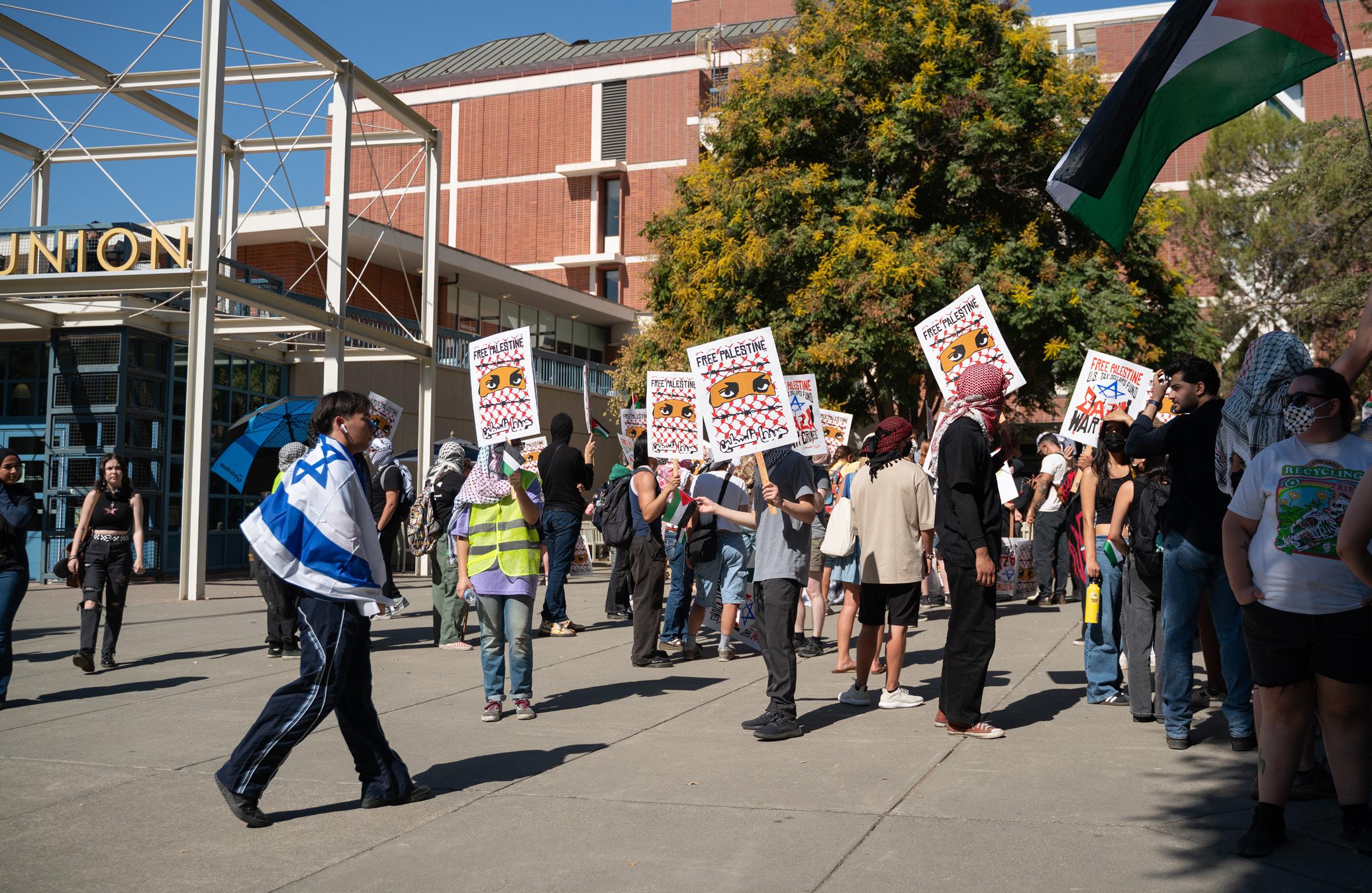
been accused of war profteering, by chanting, “Gary May, how many kids have you killed today?”
Behind the protest, a smaller group of fewer than 30 counter-protestors, including members from Aggies for Israel as well as various citizens of the Davis community, showed their support for Israel.
A couple of the counter-protestors
walked over to the pro-Palestine demonstration, yelling and taunting pro-Palestine protestors by dancing in their direction. Additionally, they were chanting, “Hate is not resistance” and “Free the hostages,” while displaying a tarp depicting Israeli hostages. One of the counter-protestors held a sign reading, “On October 7th —1,400+ people were murdered, raped and
Gaius Ilupeju divulged the wrongdoing during the Oct. 3 ASUCD Senate meeting, before ASUCD officials attempted to stifle publication of the issue

BY VINCE BASADA campus@theaggie.org
An unnamed former ASUCD unit director posted a fake vacancy and disregarded employment rules, ASUCD President Gaius Ilupeju alleged at a public Oct. 3 ASUCD Senate meeting.
“We found out this summer during interviews that a former unit director wasn’t hiring as they were supposed to, according to the bylaws, and weren’t abiding by fair hiring practices,” Ilupeju said. “[Tis unit director] put up a vacancy and they didn’t actually do interviews. Tey had their friends apply or people they knew apply and didn’t have the right people sitting in on those interviews [or] sending employment forms.”
The unit and former director involved were not identified, and their motive/possible fscal damages to the organization remain unknown. Tere was also no further information immediately given about the interviews that uncovered the mispractice or on any possible disciplinary action taken.
Te reveal of these developments to the press, which also seemed to be new information to the room full of frst-time senators and commission chairs, was made inadvertently. Ilupeju disclosed the misconduct to the senate table without registering the presence of a reporter from Te California Aggie.
No other individuals independent from the student government were present at the meeting at that time.
“If that [hiring violation] gets out of this room, we could be facing serious lawsuits,” Ilupeju said to his fellow student government ofcers.
Ilupeju and Internal Vice President Aaminah Mohammed attempted to strike his comments from the record and asked Te California Aggie to refrain from publishing the information, a request to which Te Aggie did not comply due to the Code of Ethics.
Ilupeju later provided a written statement when asked for comment.
“While we always strive to ensure that all of our units and services follow relevant policies to the best of their ability, that hasn’t always been the case in the past,” Ilupeju said.
“The event I was referencing occurred last year or the year prior, but I only recently learned about it when I assumed this role. We are doing everything we can to prevent this from occurring again.”
The information was revealed during a discussion over SB#1, enacting the ASUCD budget for the 2024-25 fscal year as well as authorizing two capital projects to improve the services and operations of the Cofee House and Unitrans. Te initial draft of the bill included wording that asserted the right of the ASUCD Executive Ofce to “suspend the budget of any entity in
violation of the ASUCD Constitution and Bylaws.” When asked by Senator Dhilena Wickramasinghe on the reasoning behind the inclusion of this clause, Ilupeju disclosed the alleged misconduct.
“Since we’ve given our units semiautonomy, we don’t really scrutinize how they spend their budget,” Ilupeju said at the meeting.
“We’ve had a lot of situations where people go over budget, and our current policy is that if [units] have debt, if they go over your budget, [and] if they end up spending more than they didn’t allocate, it comes out of general reserves.”
Tat’s not fair to students because it means that we’re not being prudent with the money we’ve been given, and that’s not fair to other units,” Ilupeju said.
“Tere’s some units that go above and beyond to make sure that they’re double checking numbers, including receipts.”
SB#1 was later passed unanimously, though with the section in question removed. Ilupeju also said at that time that he plans to hold closed session meetings to discuss the hiring misconduct further.
Editor’s note: An earlier version of this story reported that the proposed clause in Senate Bill #1 gives power to the Senate to suspend a unit’s budget. However, SB#1 gives this power to the Executive Ofce.
tortured by Hamas.”
The pro-Palestine protesters attempted to block them with umbrellas, and the counter-protestors’ actions ceased once the pro-Palestine march began.
The march went through the Memorial Union and Cofee House, down to Shields Library and the Silo, where there was a refreshment station
with water. Protestors primarily marched down streets and gathered in common areas.
Te pro-Palestine speeches at the Silo fnished by 1:30 p.m. As of the date of publication, the University of California has taken no action against protestors or organizers.
Mary L. Stephens Library, The Avid Reader and more take a stand against literary censorship
BY OLIVIA HOKR city@theaggie.org
Banned Books Week is an annual campaign that brings visibility to books that have been banned or challenged over the past hundreds of years within schools and libraries. Tis year from Sept. 22 to 28, librarians, writers, journalists and teachers focused on highlighting the diverse voices of authors who have been victims of these bans. Te American Library Association implemented the theme “Freed Between the Lines” for this year’s unition against censorship as a political statement for the freedom of storytelling and reading.
Yolo County Library took a public stance through their social media accounts and participated in Banned Books Week to encourage the community to unite against book bans. At an even more local level, the Mary L. Stephens Library in downtown Davis joined other Yolo County Libraries in shining a light on books that are being challenged and banned throughout the nation.
Scott Love, the library regional manager in the West Yolo Region, shared that Mary L. Stephens Library produced a display of challenged books. Similarly, Logos Books in downtown Davis created a display for Banned Books Week that included a printed list of the 2023 most-challenged books.
“It is important to acknowledge the attacks on everyone’s right to have unrestricted access to free books to read,” Love said. “Yolo County Library feels strongly that each individual and each parent should decide what they and their children should read, not the library.”
Te American Library Association’s Ofce for Intellectual Freedom shared data that showed a 65% increase to challenged books in 2023 compared to the amount in 2022. Public libraries and school libraries were main targets of censorship this past year. The most common reason for a book to be challenged is its representation of LGBTQIA+ and BIPOC identities within the story, according to the data. Kayla Girdner, the administrative assistant and social media manager at Te Avid Reader in downtown Davis, believes in advocating for the freedom of books year-round and fghting against the marginalization of authors.
“Tey can’t ban the books from the bookstore, but they can absolutely ban them from being accessible to people who don’t necessarily have money to go out and buy the books from a store,” Girdner said. “[Banned Books Week is] a big push in schools and bookstores to celebrate those books and make them visible in places where maybe they wouldn’t be.”
BANNEDBOOKS on 9
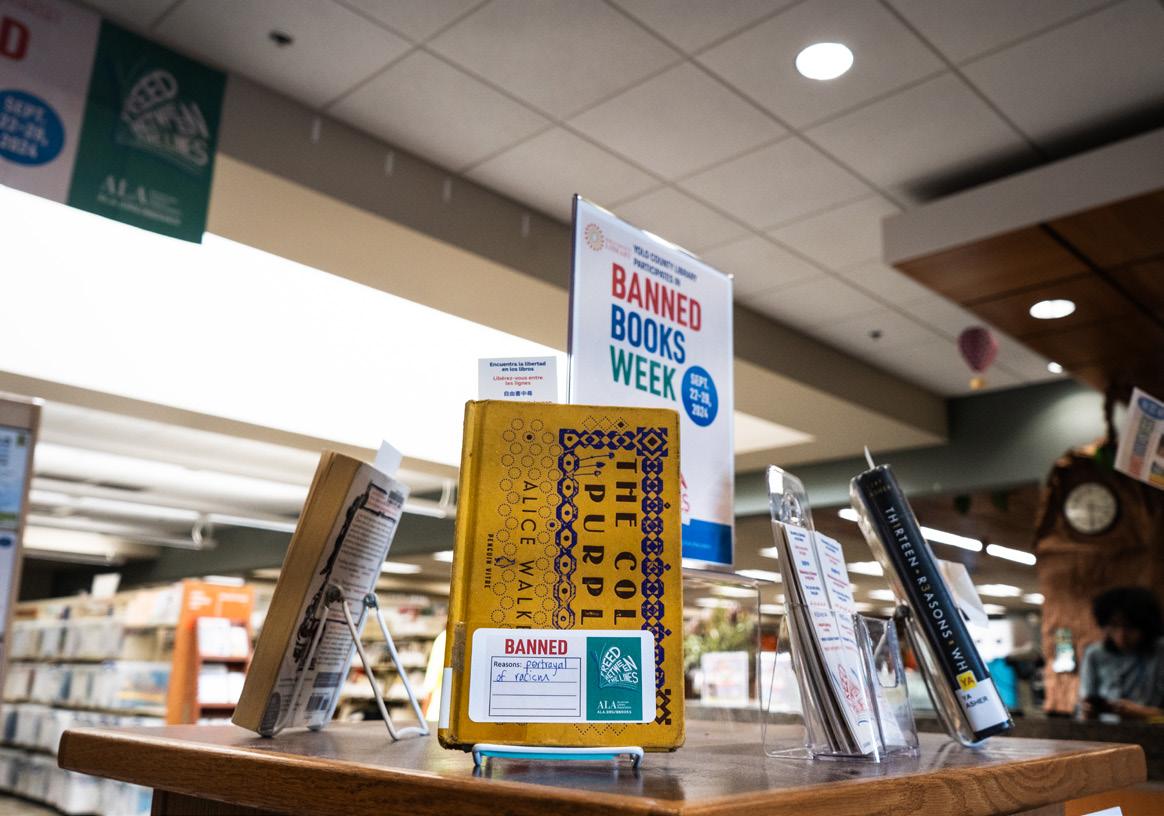
Police Chief Darren Pytel to retire after 41 Years, Deputy Chief Todd Henry named successor
BY ALMA CULVERWELL city@theaggie.org
After a 41-year career at the Davis Police Department, Police Chief Darren Pytel recently announced his retirement, scheduled for Oct. 17, 2024. Pytel’s retirement marks the end of an era for the city, as he had been a cornerstone of the department since starting as a police cadet in 1983. Deputy Chief Todd Henry has been named as the new chief, according to a city announcement by City Manager Mike Webb.
Pytel’s career in the department has been marked by a wide range of roles, including bike enforcement ofcer, watch commander, lieutenant, captain and deputy chief, before becoming police chief in 2015. Troughout his tenure, Pytel led the department through signifcant challenges, including the COVID-19 pandemic and the 2023 serial stabbings that shook the Davis community.
In addition to his leadership role, Pytel has also served as a professor in the Administration of Justice Department at Sacramento City College, a position he plans to continue after retirement. He also looks forward to spending time with his family, traveling with his wife and exploring the region’s wineries.
“I’ve had a long and amazing career with the Davis Police Department,” Pytel said in a city of Davis press release. “It has been a true pleasure serving this community and working with so many people who have been focused on ensuring a safer Davis.

I will miss so many, especially the dedicated members of the department, but I have no doubt they will continue to serve with pride and distinction under Chief Henry’s leadership.” Webb praised Pytel’s commitment and leadership to the city of Davis.
“His unique expertise and deep knowledge of the Davis community are unparalleled,” Webb said in the statement. “I wish him the best in his well-deserved retirement and am confdent that Todd Henry will continue to build on Pytel’s legacy.”
Henry brings more than 28 years of public safety experience to his new role. Henry joined the Davis Police Department as deputy chief in March 2023, after a 25-year career with the Sacramento County Sherif’s Ofce, where he developed initiatives such
as a homeless outreach team and a mental health crisis response unit. His experience in community and intelligence-led policing, coupled with his leadership roles in various public safety boards, positions him as a strong successor to Pytel.
“I am grateful and honored to have the opportunity to continue serving this amazing community,” Henry said in the statement. “Davis has welcomed me with kindness and support, and I am committed to upholding the values of integrity and transparency that the city has come to expect.”
Henry’s appointment has garnered praise from city ofcials, including Mayor Josh Chapman, who expressed confdence in his ability to lead the department.
“I would like to welcome Deputy Chief Henry into his new role as Davis Police Chief,” Chapman said in the press release. “I have full confdence that he will be a great leader for our Police Department for years to come.”
As the Davis community prepares for this transition, Henry will step into a role with both challenges and opportunities, working to continue the city’s reputation as a safe, inclusive place for residents.
Pytel’s retirement caps a career marked by dedication and resilience, and the city will feel the impact of his absence. However, with Henry’s experience and vision, Davis residents can look forward to a continuation of the department’s commitment to public safety and community engagement.
Photo Gallery: One year later, proPalestinian and pro-Israeli protesters hold demonstration on Oct. 7
BY JENNA LEE AND JESSICA YUNG

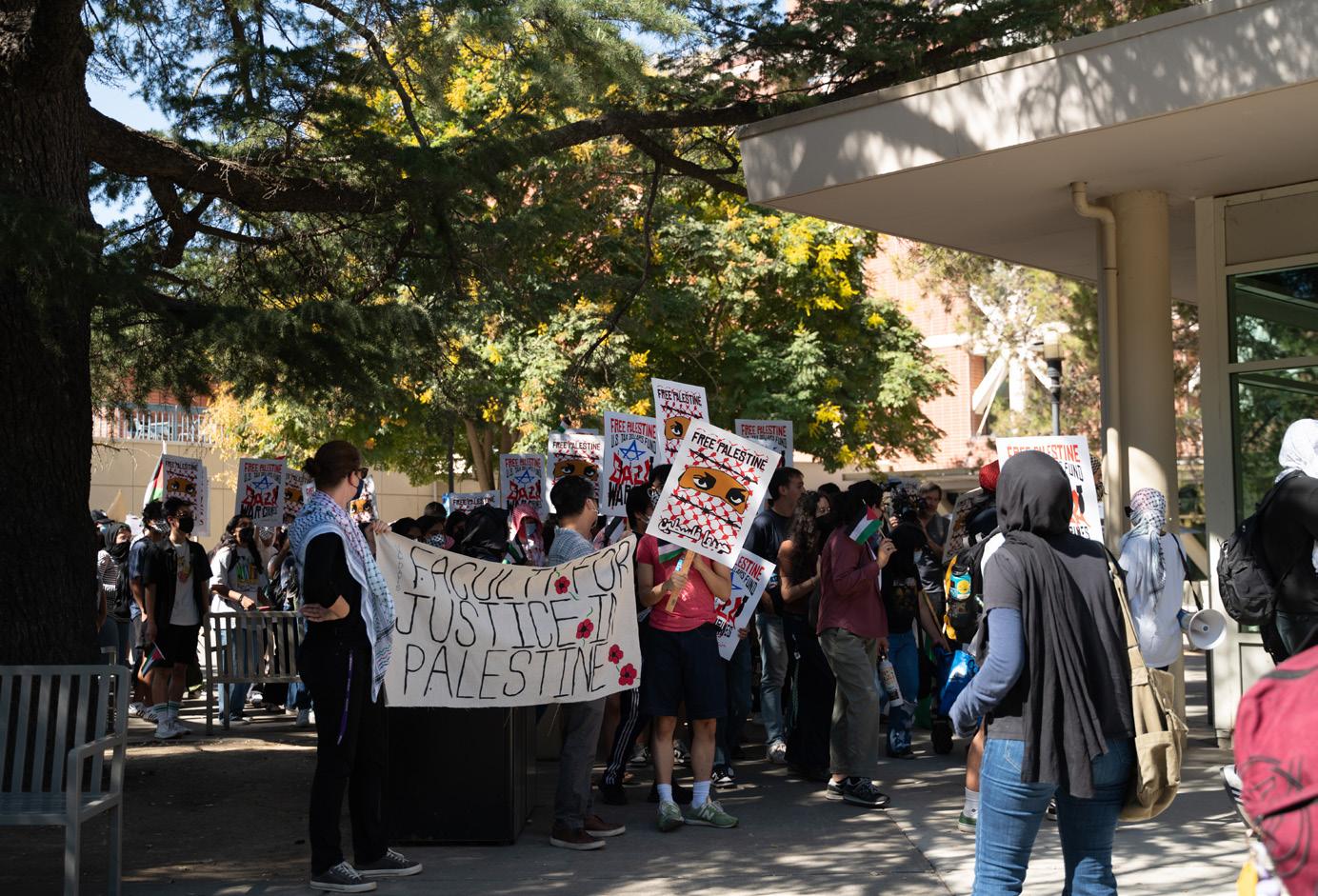

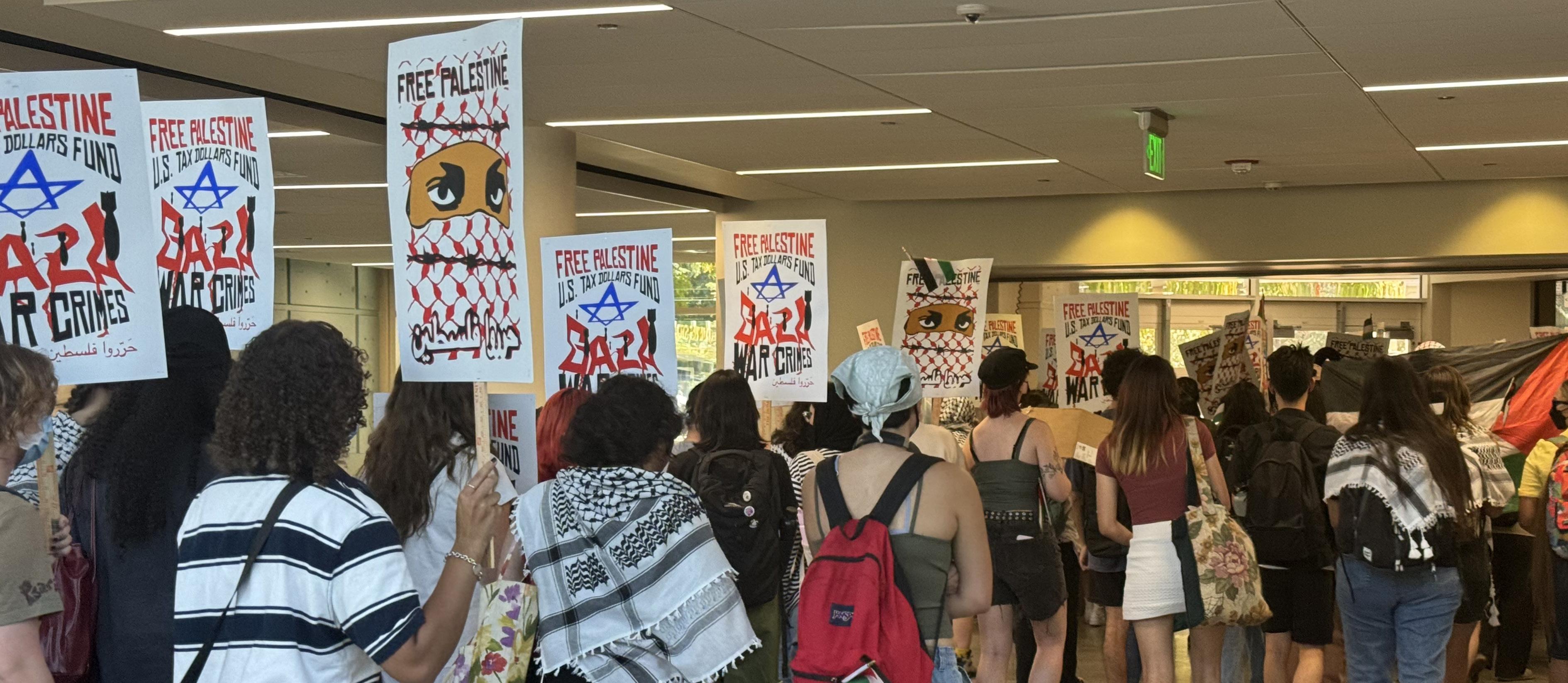
ASUCD President inadvertently divulged the issue to press several hours into the meeting
BY VINCE BASADA campus@theaggie.org
During the frst in-person meeting of the quarter on Oct. 3, the ASUCD Senate oversaw multiple appointments and confrmations. ASUCD President Gaius Ilupeju then inadvertently alleged the hiring misconduct by a former unit director during the discussion of a bill.
ASUCD Internal Vice President (IVP) Aaminah Mohammad called the meeting to order at 6:30 p.m. before reading the UC Davis Land Acknowledgement.
Te Senate moved onto nominations for senate pro tempore, a position that acts as representative of the senate and presides over it in the absence of the IVP. In a majority vote, Senator Asif Ahmed was elected over Senator Ezra Rubin.
Next, one of three remaining open senate seats was flled by fourth-year Interim Senator Max Gouvalaris. He was confrmed unanimously and sworn in immediately.
A host of senior roles were confrmed afterwards, starting with Pattarin Khajornchaikul, a frstyear international relations major, as associate vice president (AVP) of internal communications as well as Noa Sumner, a third-year sociology major, as AVP of disability justice.
Ten, the justices of the Judicial Council were sworn in including: Daniel Aquino, a fourth-year philosophy and cognitive science double major, Ashleen Kaur Rakkar, a fourth-year political science major, Diego Quintero, a third-year political science and English double major, Iman Tariq, a third-year sociology major, and Samanatha Figlietti, a third-year anthropology major. Albena Goulisheva, a fourth-year political science major, was sworn in as the deputy head justice and Katrine Lee, a fourth-year political science and

Italian double major, was re-sworn in as head justice. Afterwards, Gender and Sexuality Chair Tristen Dillard, a fourth-year psychology and human development double major, Aggie Reuse Unit Director Kate Richards, a second-year history major, and Undocuscholars Advocacy and Aid Chair Leslie Nicaragua, a fourth-year, Chicana/o studies and political science double major, were confrmed to their respective positions. Rashita Chauhan, a fourth-year economics and international relations double major, was also confrmed as chair of the Sexual Assault Awareness Advocacy Committee.
Additionally, the 11 commissioners of the Environmental Policy and Planning Commission were confrmed all at once.
Following ex-ofcio reports, Dani
Antonio, a fourth-year political science and psychology double major, was sworn in as chair to the newly formed Planet Her Committee. Antonio had previously created the debut event during her time as a senator which ended last year.
Te introduction of new legislation followed, beginning with Senate Resolution 1, which outlines the goals, priorities and business strategies of ASUCD for the academic year.
Te meeting then transitioned into consideration of old legislation, solely Senate Bill 1, which approves the budget for the 2024-25 academic year. Te fne details of the budget had largely been worked out during hearings in spring, but three amendments had been made over the summer.
Firstly, due to issues with onboarding over the summer, wages
allocated for summer pay were left unused and instead used to create a Job Creation Variable Fund which will create new positions and compensate employees at the discretion of the Personnel Committee. Te total amount reclaimed is $21,015.31.
Te other two additions requested an allocation of $4.4 million from general reserves to cover two capital projects: a CoHo Expansion for $2.7 million and a Unitrans Facility Upgrade for $1.7 million. Tat draft of the discussed bill also included wording that asserted the right of the ASUCD Executive Ofce to “suspend the budget of any entity in violation of the ASUCD Constitution and Bylaws.” When asked by Senator Dhilena Wickramasinghe on the reasoning behind the inclusion of this clause, Ilupeju disclosed that a former ASUCD Unit Director had broken hiring laws and ASCUD rules.
Te unit and former director
involved were not identifed, and their motives and impacts to the organization remain unknown. Tere was no further information immediately given about the interviews that uncovered the mispractice or on any possible disciplinary action taken.
Te reveal of these developments to the press was made inadvertently; Ilupeju disclosed the misconduct to the senate table without registering the presence of a reporter from Te California Aggie covering the meeting.
“If that [hiring violation] gets out of this room, we could be facing serious lawsuits,” Ilupeju said.
Ilupeju and Mohammad attempted to strike the comments from the record and asked Te California Aggie to refrain from publishing the information, a request to which Te Aggie did not comply in accordance with our Code of Ethics.
“While we always strive to ensure that all of our units and services follow relevant policies to the best of their ability, that hasn’t always been the case in the past,” Ilupeju later told Te Aggie in a written comment. “Te event I was referencing occurred last year or the year prior, but I only recently learned about it when I assumed this role. We are doing everything we can to prevent this from occurring again.”
Te senate went on to pass Senate Bill 1 with the clause in question removed. Te total appropriations are $10,569,594.
With discourse over the hiring issue continuing, the senate went into unmoderated caucus at 9:15 p.m., before shortly going into a break in order to speak of the public record at 9:16 p.m. After it became clear that there were no remaining public matters to discuss that couldn’t be postponed, the meeting ended with a brief open forum and adjourned at 9:19 p.m.
The three candidates running for District 2 discussed their positions on hot topics during a forum held by the League of Women Voters BY
RORY CONLON
rhconlon@ucdavis.edu
Te three Davis City Council candidates running for District 2 discussed plans to make housing more afordable, support business owners and engage with UC Davis students during a candidate forum hosted by the League of Women Voters on Sept. 26 in City Hall. Te candidates, Linda Deos, Victor Lagunes and Dillan Horton, answered questions written by the League of Women Voters and the audience.
Sophia Ocampo, a registered nurse and UC Davis alumna, said she was most concerned about how candidates would address rising costs of housing.
“I rent, and I wonder if I will ever be able to aford buying here,” Ocampo said. “I’m 40 years old now. Having been a student here before and rented here 20 years ago, I’m still facing the same issue.”
During the forum, candidates were given 90 seconds each to explain their plans for making housing more afordable to public employees and young adults.
Lagunes, the president of the Davis Teachers Association, said he estimated that 45% of educators cannot aford to live in the area they teach in but ofered a possible solution.
“Pushing for designs that are either higher in density or lower in square footage at price points more accessible for individuals [...] is one way to move the needle,” Lagunes said. “I also think that investing in our Housing Trust Fund so that we can provide down payment assistance to people starting to build their own equity in those units is another way to move the needle.”
Deos, a member of the city of Davis Planning Commission, said the frst step is to recruit public and private partners who manage mutual housing programs. She also pointed to a transportation plan to accommodate the dense housing.
“Get more density going up and around,” Deos said. “Build those duplexes, build those triplexes, build all of those, but we have to link transportation with density.”
Horton, a chair on the Davis Police Accountability Commission, is a renter in the Davis community. He proposed building more diverse types of housing and strengthening a program that supports renters in becoming home buyers.
“It’s important we prioritize building more workforce, marketrate and mixed-use housing, so that families, seniors and working folks can aford to live in town,” Horton said.
“We also need to make sure that the First-Time Home Buyer Program has money in the piggy bank. Folks like myself who want to be able to utilize the program to transition out of rental housing aren’t able to utilize that
today to move through the housing continuum.”
Candidates then discussed the fnancial health of the city of Davis. Lagunes said the key to improving the fnancial health of Davis was through passing Measure Q and supporting small businesses.
“When we talk about our economic development, we talk about our businesses and the need for a greater tax base,” Lagunes said.
“I think it’s important that our city has hired an economic development director to conduct outreach and fnd more incubators to start businesses.
I also think it’s important that our partnerships with our local nonprofts continue to thrive so they can continue to provide their services.”
Horton said that when he was talking to voters about Measure Q, he encountered resistance from people who thought the city was not doing a good enough job of managing money.
“We need better outreach to afected residents before we formulate new projects or policies, so that we don’t do one project one, two, three
times over,” Horton said. “We need to better utilize local expertise instead of paying several thousand dollars to an out-of-town consultant for almost everything we do as a city. If we do these things, we’ll rebuild broken trust with Davis voters and, at the same time, be better stewards of our city fnances.”
Deos said that passing Measure Q, which would increase the sales tax by one cent and provide $11 million a year toward essential city services, would improve the city’s fnancial health and cited her experience as a bankruptcy attorney.
“How do you build trust?” Deos said. “You put people there that you trust, and who’s somebody who can do that? How about a bankruptcy attorney who’s been looking at fnancial documents for 25 years and saying, ‘Here’s what you need to do.’ Tat’s what I’m going to bring to the city.”
Candidates also responded to how they would make local government work for students who were unable to vote in the election, either because
they were too young or because they didn’t live in the district.
Lagunes said that to increase engagement from college students, the city needs to address their needs. Te level of housing insecurity and the level of students on social supports like CalFresh are a lot higher now,” Lagunes said. “You can imagine that if your basic needs are not being met then that’s going to limit your ability to engage and access what local government is about. I think voicing that is why I was able to get the endorsement of the Davis College Democrats.”
Horton said millennials and zoomers are issue-based voters who are looking for change on issues that matter in their lives.
“I think it’s critically important that if we want more young people to be willing to vote in any election, not just a Davis City Council election, we need to, as government leaders, make progress on the issues that working-class Davis [residents] are facing in their lives every day,” Horton said. “We need to make progress on
expanding access to quality, afordable housing and making it easier to start and operate a small business in this community.”
Deos said that the key to engaging students is inviting them to get involved in city council meetings and reach out about issues afecting the community. She also pointed out the historical signifcance of the race — if elected to the city council seat in November, she would be the frst openly gay lesbian to serve on city council, and Horton could be the frst openly gay, African-American candidate elected to ofce.
“Having that presence is huge,” Deos said. “It’s the same thing if Dillan [Horton] were to be elected — I think that is so important. When I was growing up thinking about coming out, it was like, ‘Oh, Harvey Milk got assassinated, I’m going back into that closet.’ It wasn’t safe for me to come out. [It’s about] showing what’s possible.”
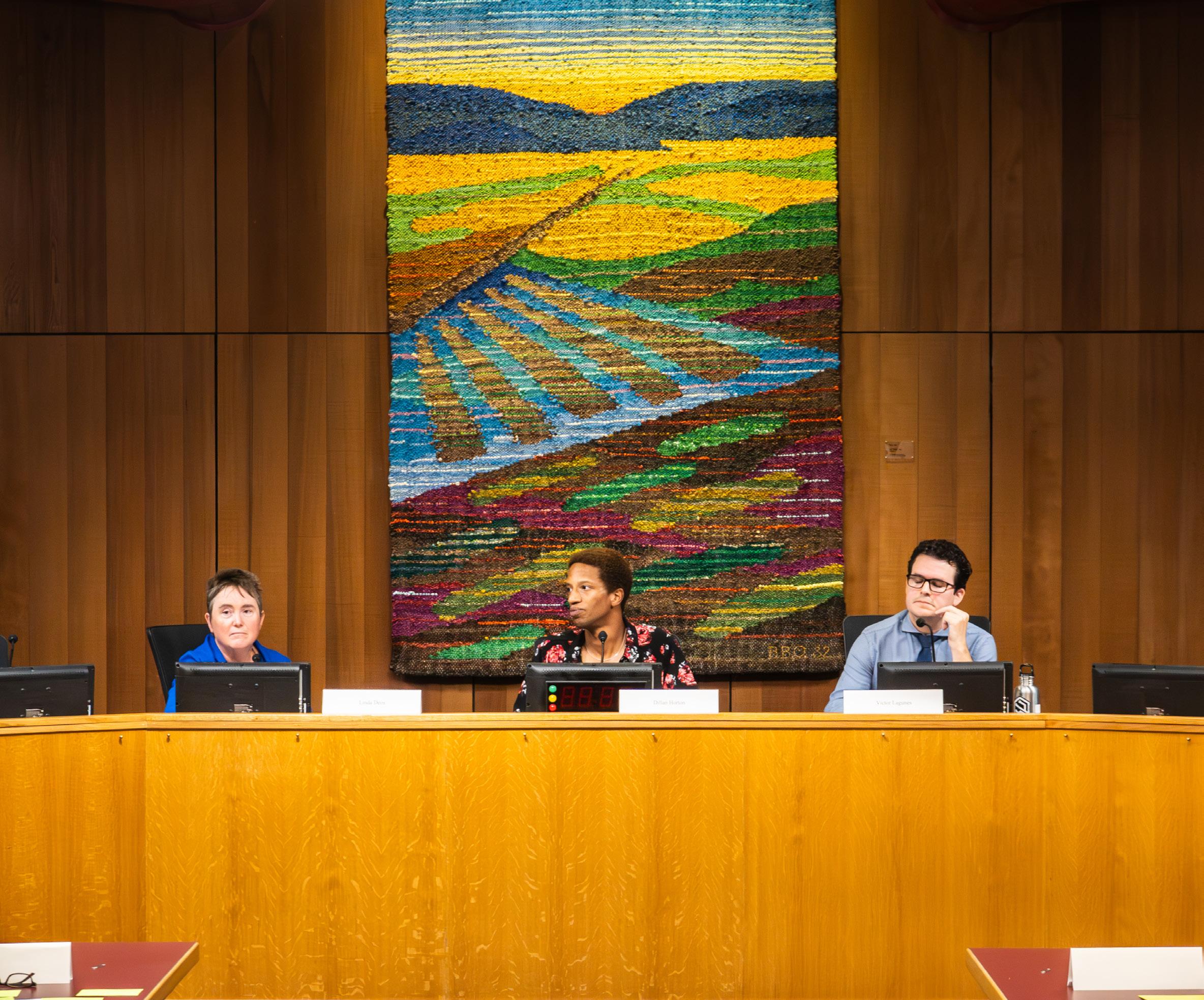

BY MAYA KORNYEYEVA mkornyeyeva@ucdavis.edu
Tis summer, something both inevitable and terrible happened — I ran out of things to listen to. My “Discover Weekly” on Spotify grew steadily worse, I fnished listening to the last audiobook of Harry Potter (voiced by the legendary Jim Dale) and I was fresh out of podcasts. All the while, I was itching for new content to listen to on my Bay Area commute.
Tat’s when I stumbled across the “Smosh Reads Reddit Stories” podcast on Spotify. I’m not an avid Reddit reader, but I’ve come across a few interesting stories here and there, along with plenty of good meme content. “Why not?” I thought to
myself and pressed play on a classic “Am I the Asshole” (AITA) episode.
It may be a smidge dramatic to say that my life changed, but I was instantly hooked on the podcast.
Tere were stories from every niche subreddit on the internet, featuring tales that ranged from wedding disasters to a cucumber-snacking addiction to cat theft. Each and every episode made me laugh, gasp in shock and critically evaluate what I would do if I was in the original poster (OP)’s shoes.
For some context, Smosh is an independent production group on YouTube started by Anthony Padilla and Ian Hecox back in 2002. It centers around skits, improv and comedy, and boasts a reputable 26.7 million subscriber base. Teir subchannels
include Smosh Pit, Smosh Games, SmoshCast and ElSmosh, which cover everything from “try not to laugh” challenges to board games to Spanish renditions of their popular videos.
Tis channel really has something for everyone and was built from the ground up even before the launch of YouTube as a company.
Tere is something inherently refreshing about listening to a casual conversation between friends. Each episode of Smosh’s Reddit podcast, no matter the co-hosts, contained a good mix of lighthearted humor, shocked silences and serious deliberation.
Many of the stories that are featured on Smosh contain numerous layers and occasionally unreliable narrators, making each one the topics of complex debate. Listening to Shayne
Topp and his co-hosts try to reason out each story and approach the post from every direction (even playing the devil’s advocate at times) was both enlightening and entertaining. It’s rare for me to hear anyone canvas out issues with such empathy and attention to detail. Often, I hear people on podcasts arguing a single point of view, refusing to accept alternative perspectives and remaining hyper-focused on their own beliefs. Smosh is unique because everything is said in a space free of judgment, and every story is given a fair and deliberate hearing. Even when reading and replying to the darkest, strangest stories, Smosh’s co-hosts manage to fnd some light and hilarity amongst it all. I also particularly love that this
podcast features three co-hosts, rather than the typical one or two, and that the production team can even be heard laughing in the back at times. Tis quality adds more dimension to the listening atmosphere created by this podcast, bringing the audience closer to the conversation and providing an immersive experience.
When you, like me, are used to sitting in a car alone and vibing to some music while driving, Smosh is an introduction to a whole new world. It’s similar to having a group of friends chilling in the backseat, chatting about stories they’ve come across online. Te various Reddit stories are also educational; after listening to a good 10 to 15 episodes (each about an hour long), I received a crash course in interpersonal communication and confict resolution. Although I had my own opinions on how to approach the diferent Reddit scenarios presented, it was gratifying to hear that my way of thinking was reasonable and by no means unconventional.
Tis is true for a lot of podcast listeners out there, and is refected in a budding feld of research about the potential benefts that can be reaped from podcasts. Podcasts are proven to engage our social selves, make us feel more productive and quench our curiosity and thirst for knowledge, according to the National Institute of Health (NIH), Listening to podcasts is meant to educate and inform, just as much as it is to entertain and amuse. Talk shows in particular are exceptional at both, and Smosh, in my personal opinion, does it better than any other podcast I’ve listened to. If you’re ever looking for some outrageous stories and a carload of laughs, look no further than the “Smosh Reads Reddit Stories” podcast on Spotify. Not only will you take away some life lessons from the experiences of people on Reddit, but you’ll feel more connected to humanity. Maybe you’ve gone through something similar to someone else’s story. Maybe you have questions and are simply looking for some answers. Or maybe it’s been a long time since you’ve laughed. In any case, Smosh’s podcast will surely take you on some unforgettable adventures.
Disclaimer: Te views and opinions expressed by individual columnists belong to the columnists alone and do not necessarily indicate the views and opinions held by Te California Aggie. Please contribute to their GoFundMe
BY ALLISON KELEHER
Lately, the economic and political state of the world has been bleak to say the least. Infation is wreaking havoc across the nation, resulting in a higher cost of living and lower disposable incomes.
Of all social classes, the one hit the hardest has got to be the squirrel community here at UC Davis. I swear these little rats won’t leave me alone when I’m eating my breakfast. I want to eat my oatmeal in peace, sue me. After this personal experience, I
came to the conclusion that this must be a father trying to provide for his family. Tis made me sad, because I should have given him my oatmeal. Squirrel blood is on my hands. Since I made this tragic mistake, I decided to take accountability and share his story.
Te following day, I returned to the same location, and I brought more oatmeal this time. I ofered it over to the squirrel, and he hobbled over in his skinny body. After a ravishing meal, I had a delightful conversation with this squirrel father.
Te squirrel father, George Knutt, has a wife, Cynthia Knutt, and three lovely children named Timmy,
Charlotte and Peter. Tey used to live in a nice, rent-controlled tree in the Memorial Union Quad. Tis lovely location was flled with acorns to scavenge for and unsuspecting students to steal food from. Everything was going great for the family. Mr. Knutt would spend the day scavenging while his family would keep up the tree in his absence.
Ten, things slowly became more difcult. It started when Mrs. Knutt began scavenging as well, turning them into a dual-income tree. Tis tore the patriarchal family dynamic apart. Mr. Knutt no longer felt like a high-value male squirrel. He numbed this pain by
having relations with a nearby squirrel siren. When Mrs. Knutt found out, their family was left in shambles. Meanwhile, a nearby industry of squirrels in the largest tree on the Memorial Union Quad were left unharmed. Te leading squirrel, John D. Acornefeller, hoarded all of the local acorns and seeds in his large tree. Acornefeller, with his large labor force of lowly squirrels, collected all of the food sources nearby, leaving middleclass squirrels with nothing — middleclass squirrels such as the Knutt family. To make matters worse, Acornefeller has strong political ties, which silence any potential
competitors. Tis rising infation is leaving the Knutt family in disrepair, and the Acornefeller corporation wants to keep it that way. I bet Acornefeller doesn’t even pay his taxes. Tis blow-out discovery of mine is going to shock the masses. As a nation, we need to support and uphold the Knutt family. Please support their GoFundMe so that we can get them back on their paws.
Disclaimer: (Tis article is humor and/or satire, and its content is purely fctional. Te story and the names of “sources” are fctionalized.)
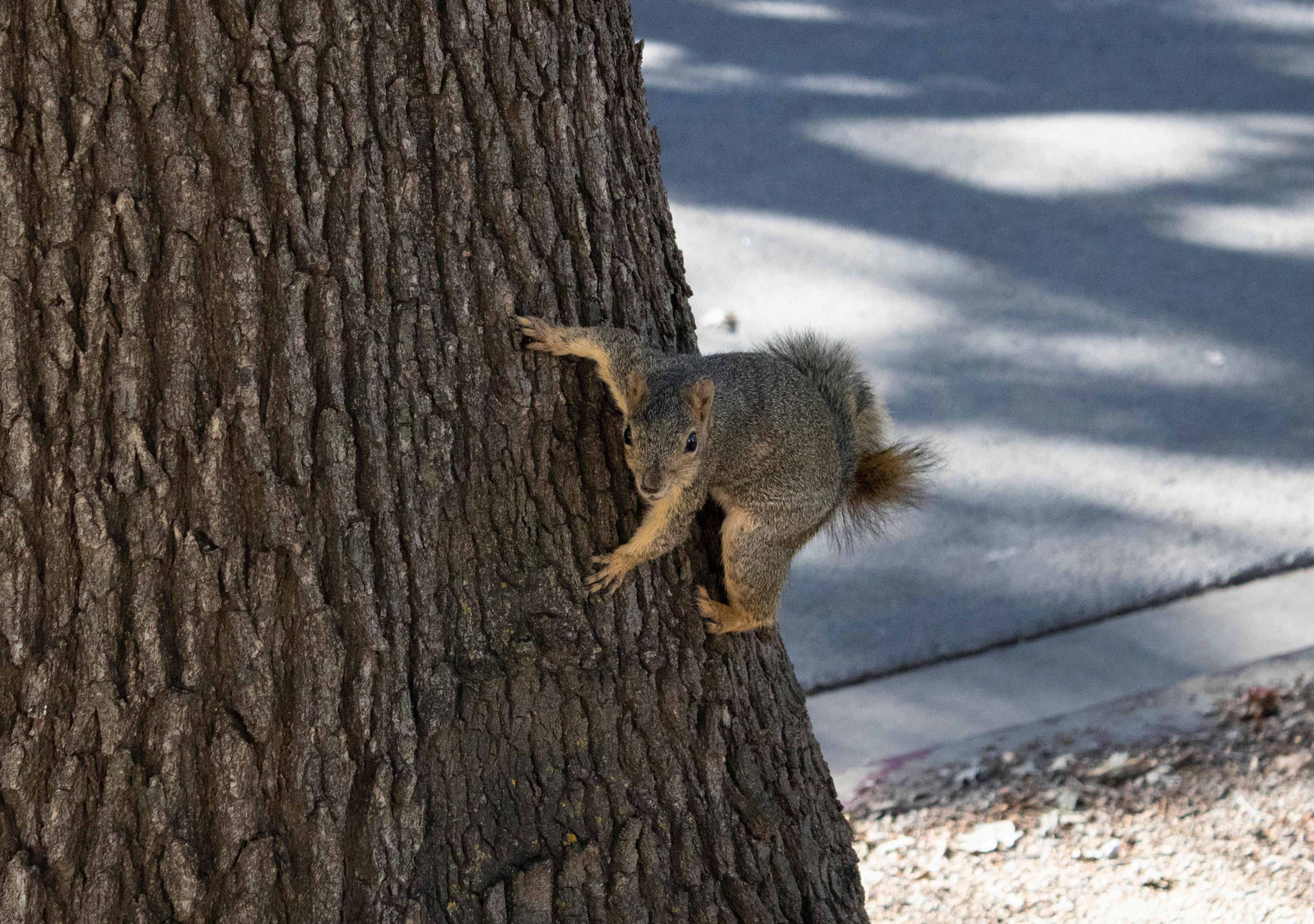
The Editorial Board condemns collective punishment overseas
WRITTEN BY THE EDITORIAL BOARD
On Oct. 7, 2023, Islamic Resistance Movement Hamas conducted an armed incursion into the Gaza Envelope of Southern Israel.
Te invasion was the frst to enter Israeli territory since the 1948 ArabIsraeli war, and the day of the attack coincided with the Jewish holiday Simchat Torah. At least 4,300 rockets were launched into Israel, 695 Israeli citizens were killed as a result of the attack and Hamas took 254 people hostage.
Te invasion initiated the ongoing Israel-Palestine confict and Oct. 7, 2024 marks a year of violence, turmoil and what the United Nations (UN) has called an “ethnic cleansing.” Tis past year, at least 41,870 Palestinians have been killed, or one out of 55 people in Gaza. At least 1,139 Israeli
SEE ONLINE
Scan to read our online editorial about the vice presidential debate

people have been killed since Oct. 7, 2023, with upwards of 8,730 Israeli people injured.
Tough the origins of the IsraelPalestine confict are debated, some believe it dates back to 1882 with the arrival of Jewish settlers to Ottoman Palestine as Zionism was on the rise in Europe. Zionism refers to the Jewish nationalist movement that seeks to establish a Jewish state in Palestine, which is the ancient homeland of the Jewish people.
Tis last year has been profoundly destructive to the Palestinian population. Te UN conducted an investigation into potential violations of international law that occurred throughout this confict and found evidence of indiscriminate attacks by Israel on Palestinians. Tese violations include blatant disregard of civilian casualties, deliberate attacks against Palestinian civilians without justifable military objectives and a deprivation of human rights through Israel’s blockade of the Gaza strip.
Israel has a rocket interception military defense system, referred to as the “Iron Dome,” which has a 90% efcacy rate. Most of the confict has occurred in the Gaza strip, resulting in more than half of residential buildings being either damaged or destroyed.
In an era of social media, content covering the Israel-Palestine confict has been ubiquitous. Online propaganda and disinformation relating to Gaza have been unprecedentedly vast and further reaching than anything seen before, according to the New York Times.
Research suggests that Iran, Russia and China are exploiting the confict to spread false information about events in Gaza for geopolitical gain by slandering the United States
for its backing of Israel. Tough disinformation has been rampant, the 1.9 million displaced Palestinians in Gaza lack the privilege of turning away from social media when the war becomes “overwhelming.”
Te “world war online,” as referred to by Te New York Times, has had harrowing implications on Islamic and Jewish people alike across the globe. Just in the United States alone, incidents of anti-semetism have increased 400% since Oct. 7, 2023.
Te Council on American-Islamic Relations reported a 182% increase in the average number of reports of bias incidents against Muslim people since 2022.
Despite the fact that not every Palestinian civilian is afliated with Hamas and not every Israeli civilian supports the Israel Defense Forces’ military response, real people around the world are facing violence and hate speech every day because of this confict in the Middle East.
Tough this is contrary to mainstream conversations surrounding the confict, it is possible to be sympathetic to the enormous loss of Palestinian life this past year without being a proponent of violence against Israeli citizens or the Jewish community at large.
Te events of the IsraelPalestine confict this past year alone have consisted of horrors beyond imagination. Te Editorial Board unequivocally condemns the killing of civilians and the loss of innocent life that has occurred.
As this confict worsens and extends to Lebanon, we must face the destruction happening before us. Tere may be ambiguity in the origins of this confict, but the tragedies of this past year are strikingly clear.
Editorial Board
CHRIS PONCE Editor-in-Chief
ALYSSA CREVOISERAT Managing Editor
MADISON PETERS Campus News Editor
HANNAH SCHRADER City News Editor
MAYA KORNYEYEVA Opinion Editor
ZOEY MORTAZAVI Features Editor
ANA BACH Arts & Culture Editor
MEGAN JOSEPH Sports Editor
KATIE HELLMAN Science Editor
JENNA LEE Photo Director
ARIANA NOBLE Layout Director
LANHUI ZHEN Design Director
JOANNE SUN Social Media Manager
AARON POTTER Website Manager
CASSIDY GILLIS Distribution & Outreach Director
TIFFANY HE Copy Chief
JENNY DYE Copy Chief
SAMUEL RUIZ Translation Director
ILEANA MERAZ Translation Director
LAURIE PEDERSON Business Development Manager
I’ve stopped taking lecture halls for granted
BY MOLLY THOMPSON mmtthompson@ucdavis.edu
It’s safe to say that we all pay a lot of money to be here. Granted, that funding comes from a myriad of diferent sources (government loans, savings accounts, sponsored scholarships, etc.). But everyone agrees that higher education, especially at a large and well-renowned institution like UC Davis, is abhorrently expensive.
But hey, we’re paying for fascinating, high-level classes taught by prestigious, noteworthy scholars. We’re paying for access to state-ofthe-art equipment and facilities, an enviable library of resources and an overall engaging education that prepares us for the professional world. So it’s at least justifable to a certain extent, right?
I truly believe that a high-quality education is invaluable. I’m not
trying to justify the actual net cost, but I do think it’s worth a lot. What’s more difcult for me to justify is the education I receive from asynchronous classes. Most of our classes here at UC Davis take place in classrooms and lecture halls, with professors teaching in person, interacting with students and passionately lecturing to the individuals sitting in front of them. While large lectures can sometimes feel like a one-way street with few elements of conversation, conventional classes actually retain a lot of benefcial elements. Tis includes the opportunity for students to ask questions, the sense of accountability that accompanies an academic environment, nonverbal feedback between the lecturer and the audience and more. All of this makes traditional collegiate classes efective and worthwhile. It’s hard to preserve the value of lectures through a diferent format.
Tis is not for a lack of trying, though. Te virtual, asynchronous class format that was born of the COVID-19 pandemic is an attempt to make higher education more accessible and less expensive in a variety of situations. It made sense given the severe constraints of the pandemic, but it doesn’t make sense anymore.
Asynchronous classes inherently lack some of the most valuable attributes of in-person lectures; there’s no opportunity for students to ask questions or interact with the professor. It’s a lot easier to get distracted or slack of while attending virtual lectures in your home or third space, and there’s no way for the lecturer to gauge how the audience is receiving the information they’re relaying.
All of this amalgamates to make virtual classes a lot less valuable than conventional classes. Objectively, the vast majority of students take signifcantly less away from
asynchronous lectures than they do from in-person ones. And yet, we’re still paying the same amount of money for virtual classes that are a lot less benefcial as we are for classes with interactive, engaging and lively environments.
Te issue I have isn’t with the fact that virtual classes are ofered at all — it’s certainly true that some people are more comfortable and productive with asynchronous formats. Rather, what I take grievance with is the fact that certain classes are exclusively ofered virtually.
I personally have a difcult time retaining the level of care and depth of understanding I consider to be valuable in asynchronous classes compared to conventional classes, so it’s frustrating to me when a class that I need to complete my major or that interests me isn’t available live.
Last year, I had to take an introductory communications class that was only ofered online. I think
the material could have been really interesting if it was delivered in a dynamic and interactive format, but instead I was stuck watching YouTube videos from 2013 on my own, thinking about how much money I was paying for it the entire time.
I understand that virtual classes have certain benefts, and this is not to say that they should be eradicated, but simply that they aren’t equally comparable to in-person teaching formats. It’s been proven time and time again that students perform better when they’re engaged in classes, and it’s intrinsically difcult to truly engage with a computer screen, regardless of what’s on it.
Disclaimer: Te views and opinions expressed by individual columnists belong to the columnists alone and do not necessarily indicate the views and opinions held by Te California Aggie
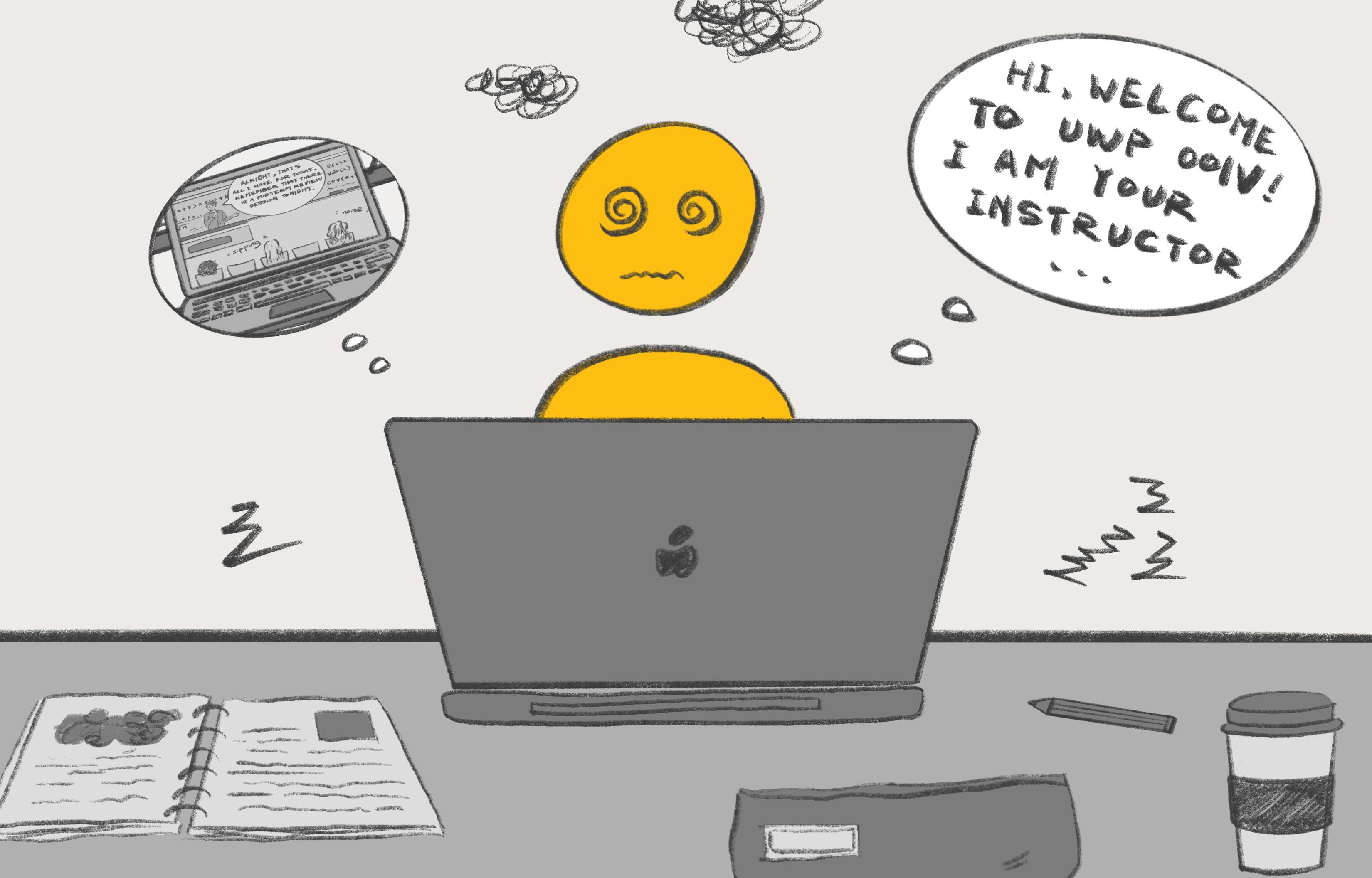

In honor of Hispanic Heritage Month, enjoy these four picks created by Hispanic and Latinx artists!
BY SAVANNAH ANNO arts@theaggie.org
Song: “Lejos de Ti” by Te Marías (2024)


Referring to themselves as the “psychedelic-soul lovechild” of lead singer María Zardoya and band member Josh Conway, Te Marías blend almost every genre under the sun: indie rock, funk, latin pop and even jazz. Simply put, listening to Te Marías makes you feel cool. “Lejos de Ti,” the eighth track on their most recent album “Submarine” details the isolating aftermath of a breakup. With trance-inducing vocals, Zardoya promises to keep her ex-lover in her memories forever, despite how much it may hurt at frst, and begs him to do the same.
While the lyrics seem simple on the surface, what may be most interesting is the possible backstory behind the breakup song. Along with tracks like “Sienna” and “Echo,” fans speculate “Lejos de Ti” was based on the real-life split between Zardoya and Conway who were in a relationship from 2016 to 2022. In “Lejos de Ti,” perhaps the two are promising to each other that despite the end of their romance, they’ll keep their memories intact in order to preserve their creative partnership.
Book: “Blackouts” by Justin Torres (2023)
I frst heard of Torres last fall in a queer fction course when we read and revered his debut work, “We the Animals” (2011). In his second novel, “Blackouts,” Torres grows into an even better writer as he weaves a story that feels unreliable and all too real at the same time. Te book tackles the issue of queer erasure both literally and fguratively. Struggling with gaps in his consciousness, 27-year-old narrator Nene seeks out Juan Gay, an older man he met a decade prior at a mental hospital. Both institutionalized for being queer, Gay, who is now on his deathbed, bestows upon Nene his unfnished task of chronicling the research of Jan Gay, who interviewed queer folk and even published a book, “Sex Variants: A Study of Homosexual Patterns” (1941). Torres brilliantly blends real life history with his own fction: Jan Gay was an actual researcher, and the book really was published in 1941. Te title “Blackouts” references the copy of the Jan Gay book passed down to Nene that is selectively flled with scribbled-out words and paragraphs to form new messages and meanings. Similarly, the book was misconstrued in real life when it was used by other researchers to create stereotypes and criminalize the queer community. As Nene works to commit Juan Gay’s oral history to memory while immortalizing the stories that came before him, the pair recount their lives and experiences in an emotional whirlwind of a novel. Coupled with unimaginable prose, the story will leave you inspired, probably sobbing, but most importantly — hopeful.

TV Show: “Los Espookys” by Julio Torres, Ana Fabrega and Fred Armisen (2019)
By coincidence, another Torres! Switching out heartbreaking for hilarious, “Los Espookys” has proved Julio Torres to be a comedic visionary. Beginning as a writer for Saturday Night Live — which led to four diferent Emmy nominations — Torres left the show in 2019 to begin his own projects. With Fabrega and Armisen, “Los Espookys” marks the beginning of a universe all of Torres’ own: brightly colored, blunt and ultimately confusing with its out-ofthis-world scenarios — literally.
Following a group of four odd and supernatural-obsessed friends, “Los Espookys” tells a classic tale as each character learns the importance of following their dreams and staying true to themselves. Unlike these classic tales, the characters’ dreams include success in the horror business. Each episode chronicles the team helping a diferent customer by faking the existence of aliens, sea monsters and other strange creatures. As the show progresses, the line between real and imaginary gets increasingly blurry as they become involved with strange politicians, cursed mirrors and psychic water spir

Movie: “Pan’s Labyrinth” dir. by Guillermo del Toro (2006)
As Halloween begins to creep up on us, so do those childhood monsters we used to look for under beds or behind closet doors. For me, one of the scariest was del Toro’s Pale Man, a monster whose eyeballs were not kept in his head but on the palms of his hands. Te story begins with Ofelia, a young girl living in 1944 Spain, who moves to the countryside with her pregnant mother and violent stepfather. As the stepfather, Captain Vidal, begins to hunt down Spanish rebels, Ofelia is whisked away into her own mission. Meeting a faun who leads Ofelia to believe she’s the reincarnation of a lost, otherworldly princess, she is given three tasks to complete through an ancient stone labyrinth. Faced with monsters in both the real world and underground, Ofelia’s fantastical journey works to represent the historical confict of Francoist Spain, a period of dictatorship following the Spanish Civil War. With a meticulous eye, del Toro is able to perfectly balance horror, folklore and history in this perfect October watch.


The children’s movie holds up even when viewed through an adult lens
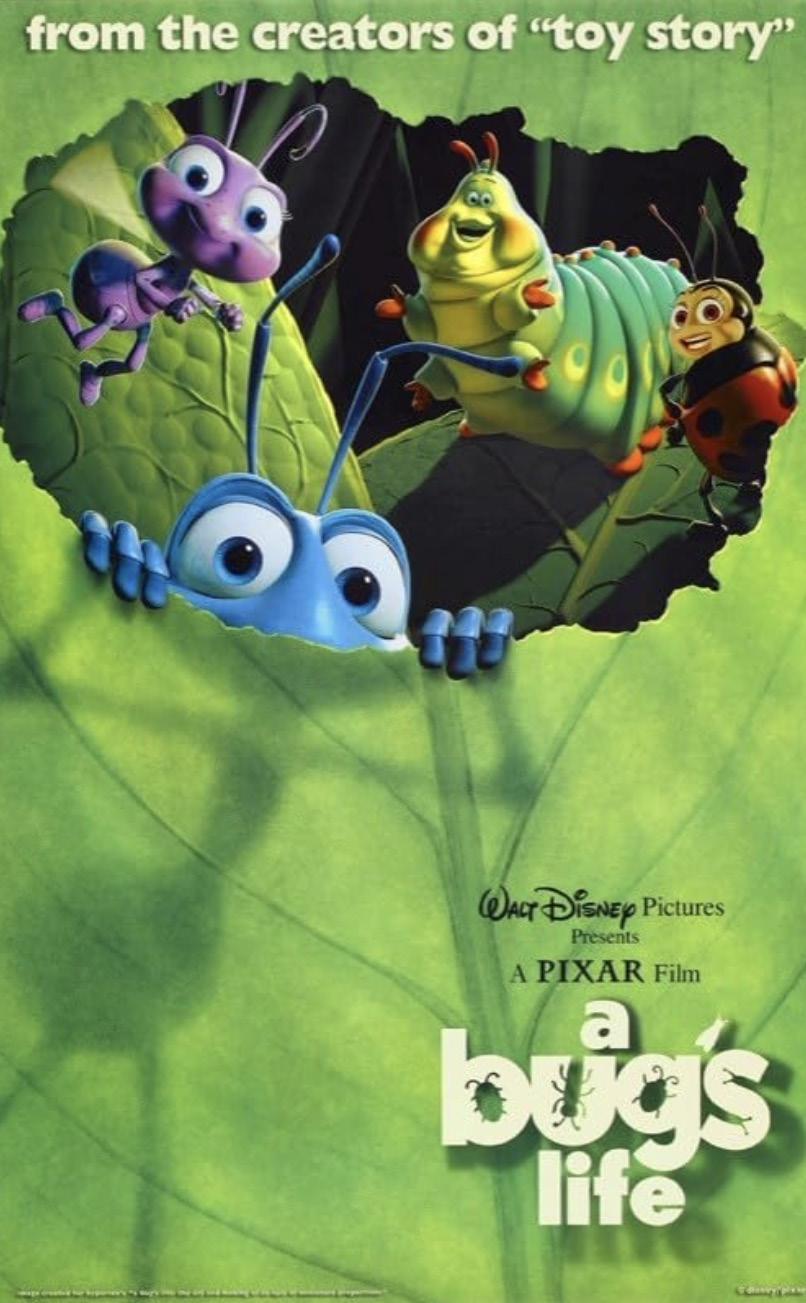
BY JULIE HUANG arts@theaggie.org
As adults, circling back to flms we watched as children can often evoke feelings of nostalgia and joy that are reminiscent of the twists and turns of childhood. One such flm is “A Bug’s Life,” Pixar’s second computer-animated flm, which was released in 1998. Te flm follows Flik, an ant with a penchant for inventions that seem to cause more harm than good to the ant colony that he calls home. Having been subjugated by a group of grasshoppers, the ants must gather food for both themselves and their tormentors, until one of Flik’s inventions destroys the food ofering. Princess Atta sends him on a mission to fnd warrior insects to defend the colony against the grasshoppers — a disguised ploy to get rid of him for good. When he comes back with a group of circus bugs that he believes are strong warriors, Flik realizes that he must devise another plan to protect his colony, using his knack for inventions.
Tere are some things about “A Bug’s Life” that may not hold up during a rewatch 26 years after its initial release.
For one, the crowd shots feature dozens of CGI ants moving in synchrony and all sporting the same facial expressions. Te disproportionate scale of the characters also inspires feelings of uncanniness. In real life, seeing a garden ant nearly the size of a grasshopper would probably be a terrifying experience.
Despite these flaws, the movie itself ultimately makes for a valuable experience due to its lighthearted approach to a mature story and themes that might have been accompanied by a much darker atmosphere if not written for a children’s movie. When viewed by those who have gained the perspective of adulthood, it is clear that “A Bug’s Life” contains heavy concepts such as power struggles between groups of people (or insects) and glimpses into the strategies used by oppressors to maintain hierarchical systems of oppression.
Tese ideas are handled with care and woven seamlessly into the plot and dialogue of the movie, so that every scene seems believable instead of heavy-

handed. An explanation coming from Hopper, the leader of the grasshoppers, on how to crush the ants’ spirits so that they forget their strength in numbers seems like a sufficiently villainous speech for the main antagonist of the movie. Meanwhile, older viewers are able to make the connections between Hopper’s actions and real-life dynamics between oppressor groups and the people they oppress.
Te movie’s plot is also driven by the pressing concern of fnding enough food to support oneself and one’s family unit. Te idea that food is a necessity is obvious to all, including children. However, adult audiences, who are more closely acquainted than children with the daily ins and outs of buying, preparing and budgeting for food, may more readily appreciate the arduous efort the ants must put in to gather foodstufs.
Rewatching the flm in adulthood also adds new emotional layers to the characters, brought about by adult audiences’ ability to draw from a larger bank of lived personal experiences and refections on those experiences. Flik’s beginnings as an outcast with diferent interests and attitudes than the rest of his colony are reminiscent of the classic adolescent experience of feeling diferent and therefore isolated. As the audience follows his character arc from outcast to celebrated hero, they are presented with the idea that their interests and ideas, no matter how diferent, hold the key to personal fulfllment. Already a valuable message to receive in childhood, older audiences who have lived through circumstances similar to Flik’s are able to bring their own memories to the flm, infusing the viewing experience with rich personal meaning.
As a children’s flm, “A Bug’s Life” is appropriately cheerful and silly, featuring a bright color palette and an eclectic cast of characters. The childish visuals and cheery atmosphere are supported by a well-developed foundation of themes and concepts with the potential to resonate with audiences much older than children.
Rockstar Games’ critically acclaimed video game is considered one of the greats, but it’s the game’s emotional core that makes it so phenomenal
BY NATALIE SALTER arts@theaggie.org
In an industry so diverse in its oferings, it can be hard to properly defne what qualifes as a video game masterpiece. No two games are fully alike, and there are a thousand diferent factors to consider: the gameplay itself, the story, the quality and performance of graphics, the characters and their motion-capture performances, to name a few. Tis sheer volume of variables means that a game can seldom satisfy every single qualifcation and hit every single mark without sacrifcing something else in the process.
Te most detailed and expansive of open-world games are often weaker in their stories; those games which are motivated by storytelling frst and foremost often limit themselves to that narrative and ofer the player little freedom beyond it. Tus, it is no small accomplishment for a game to not only balance but succeed in each and every one of these categories — and if there is one game that has done this exceedingly well, it is the 2018 action-adventure title “Red Dead Redemption II.”
Remaining to this day one of the most critically acclaimed games of the
last decade, Rockstar Games’ “Red Dead Redemption II” is a genuine triumph of the modern video game. Players are thrust into a captivating fctionalized picture of 1899 America as Arthur Morgan, an esteemed member of an infamous gang of outlaws fghting to retain their lawless ways as the age of the gunslinger comes to a close. Once the expository passage of the game is completed and all of the features of its world and gameplay become available, what ensues for any new player is an unforgettable experience which is nearly impossible not to fall in love with.
Filled with lush scenery and incredible detail captured with the game’s hyper-realistic graphics, it’s hard not to fall in love with the immersive world “Red Dead Redemption II” creates. Te landscapes are expansive and full of thousands of unique quests, conversable side characters, skill-based activities such as fshing or bounty hunting, secrets and even treasure maps leading to piles of gold. Te game’s attention to detail and commitment to immersion is genuinely commendable. Te world of “Red Dead” feels alive in every sense: characters interact with each other around your camp and beyond regardless of player intervention; wolves play with each other in the snow; and construction workers
hammer individually animated nails into boards. With thousands of possible conversations and discoveries, the entire world reacts to and interacts with the player as vividly as the player interacts with it.
Te game’s story is likewise anything but forgettable, following the inner workings and disputes of the central Van Der Linde gang as they are hunted by government agents and embroiled in the sociopolitical conficts of the regions they pass through. It is a feat of video game storytelling that is relentless to the end, leaving you hardly able to turn the game of for a second.
Moreover, the characters are brilliantly crafted and brought to life by the voice and motion-capture acting. Protagonist Arthur — the subject of no small amount of critical praise for his deeply emotional journey and striking internal and external struggles — exhibits a complexity of nature and growth which is near unparalleled in the video game industry. His interpersonal relationships are just as captivating, interacting and connecting with the gang’s members as they all struggle to fnd a way out of a world that is closing in on them from all sides. None of the emotions, relationships or decisions integral to Arthur’s story are middling in impactfulness. Te
result of this is one of the most human characters created in the industry who, if you choose to play “Red Dead,” will prove to be unforgettable long after you’ve moved on to other games. Among the many components of this game to note, one of its most daring implementations is an honor system wherein the player receives positive or negative “honor” points according to the morality of their choices throughout the narrative and beyond. Tis honor level afects the course of the story and even the ending of the game, pushing players to interrogate their own decisions and what they believe to be right. From being given the choice to give money to a beggar or help a lost man fnd his way home to making incredibly weighted choices near the game’s end, players are, just like in real life, continually given the opportunity to do what is right for themselves or, though it may be inconvenient or hard, the kind choice. Te combination of the branching honor system and the sheer variety of ways in which players can confront situations they fnd themselves in ensures that no matter how many times you play the game, you’ll have a new experience every time.
It is an achievement on its own to create a game as detailed and enjoyable to play as “Red Dead Redemption
II”; it is another to intertwine this experience with a deeply moving story which may bring even the most stoic of players to tears. “Red Dead” boldly ventures to ask us what we consider “good.” Can a person be entirely good or evil by nature? Are we defned by our mistakes, or by our acts of good? Is it only the largest and most sweeping acts of righteousness that change the world for the better, or are the little kindnesses we can carry out each and every day just as important?
Tese questions, left largely to the players themselves to answer, lay the foundation of the game’s story. Although players can choose to live as reckless and bloody a criminal life as they wish, it is the “high honor” arc of the game that is perhaps the most impactful.
Te world is complicated; it’s often flled with pain and fear, and doing the right thing is seldom easy. And yet, you can choose to be kind, to help the people and places around you even if it is in the littlest of ways. Tat, “Red Dead” seems to insist, is the true meaning of courage. And if there’s one thing to take away once you put down the controller and wander back into the uncertainty and fear of real life,

The animation industry needs more original films, not sequels
BY AALIYAH ESPAÑOL-RIVAS
arts@theaggie.org
Tere is currently an ongoing trend in the animation industry: sequels. More specifcally, sequels, threequels and tetralogies of flms that do not need another installment. As children, we were told that the princesses lived happily ever after and that’s it. But not anymore. Instead, studios such as Disney and DreamWorks are choosing to continuously produce installments of blockbuster flms at the expense of original stories.
Tis year alone, three of the highest grossing animated flms were all sequels or tetralogies. “Kung Fu Panda 4,” “Despicable Me 4” and “Inside Out 2” have made a combined box ofce of nearly $3 billion worldwide. Moreover, this November “Moana 2” is slated for a Tanksgiving release, a primetime slot that will no doubt make millions for Disney. Although these sequels are often a fnancial success, they oversaturate the movie production feld and can bar the production of new, original movies.
Tis can happen due to two reasons: either there isn’t any promotion for the non-sequel flms or it is shucked to streaming services. Te biggest culprit of this act is Disney and their treatment of their subsidiary Pixar Animation Studios. During the pandemic, Pixar provided audiences with original stories such as “Turning Red,” “Luca” and “Soul” despite being released on the Disney+ streaming service. Once audiences returned back to the theaters, however, Pixar stopped producing
movie bombed at the box ofce, causing Pixar executives to go back to the drawing board.
Additionally, two Disney animated flms were released and performed poorly as well due to minimal promotion: “Strange World” (2022) and “Wish” (2023). As a result of expectations not being met repeatedly, Disney and Pixar returned to what is most comfortable: preexisting properties that are known to make money, otherwise known as “Moana 2” and “Inside Out 2.” “Inside Out 2” is now the highest
grossing flm of 2024. Its success, while a win for Pixar and Disney, is a worrisome sign for the future of animation. At the D23 Expo this year, the conference hosted yearly to announce Disney’s newest projects across their subsidiaries of Marvel and Pixar, they confrmed more sequels. It was announced that “Frozen 3,” “Frozen 4,” “Te Incredibles 3” and “Toy Story 5” are slated to be released by 2030.
Other than Disney, “Shrek 5,” “Sonic the Hedgehog 3” and “Te Super Mario Brothers: 2” are also slated to be released by 2026. Despite expectations not being met for original flms, studios should not give up on producing them. Tere are plenty of new original animated flms releasing soon such as “Te Wild Robot,” “Piece by Piece” and “Transformers One,” that deserve the same recognition as all of the sequels from this year. Although sequels make millions, it’s only a matter of time before audiences lose interest in these beloved characters. Tese studios need to realize what made them stand out was their original stories. By only producing sequels, they are tabling their ability to creatively produce new, rich narratives.
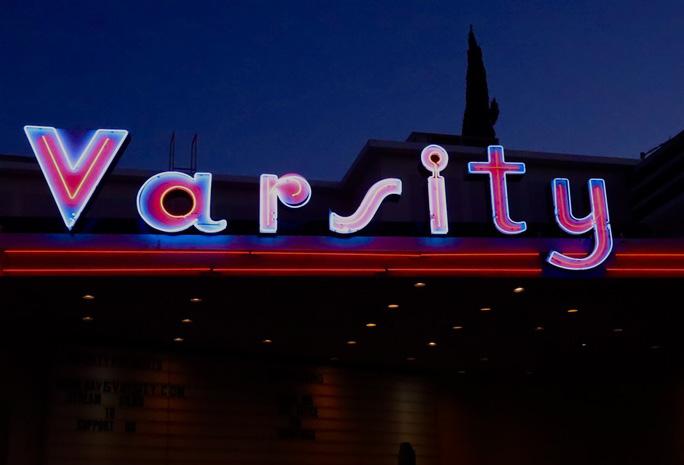
Matt Talbott plays a solo show at Armadillo Music
BY ELIZABETH BUNT arts@theaggie.com
On Oct. 2, after the storefront closed for the night, a small crowd of music lovers quietly descended on Armadillo Music, a vinyl record and CD shop located in downtown Davis on F Street. Te main draw was a oneman show played among the boxes of records. Te artist was Matt Talbott, the former lead singer and guitarist of the alt-rock band Hum.
Leading up to the show, there was little to no press provided by Armadillo. Te only sign that a concert would take place was an Instagram post featuring Talbott’s name and the incorrect date for the show. In true indie fashion, those interested in attending had to track down Talbott’s Facebook (which had not been linked to the Armadillo post) and buy tickets from a third party website. Armadillo capped the number of attendees somewhere around 30. Anyone who had not bought tickets through the Facebook page was able to enter only by paying in cash.
Once inside, the crowd settled around the tiny stage set up in the front corner of the shop. An Armadillo employee at the back of the store served beers on tap and chatted with the regulars. Alongside couples, the unofcial uniform of black band tees and jeans seemed to ring true with the middle-aged audience. College students flled in the gaps among them in groups of three or four, with many sporting fshnets and long hair.
Talbott emerged and took a seat on stage in a wooden chair with green cushions that looked like it could have come from an estate sale that morning. He wore a shirt that read, “Someone in Des Moines Loves Me.” Te lights went of in Armadillo, save for a single spotlight aimed above Talbott’s head. Te audience rustled as they sat in
front of his feet and amps, and the air could only be described as reverent. Te show itself was simple and intimate while the music was moody and atmospheric. By way of instruments, Talbott only had his two acoustic guitars and an analog foot pedal that allowed him to loop background noises and his voice. He played for just over an hour, telling stories about life on the road and the Sacramento DMV in between songs. Occasionally, Davisites illuminated by the streetlights outside would walk past the windows, peer into the darkened store at the little gathering and continue on their way. It only added to the ambiance and uniqueness of the concert. When Talbott had fnished his set, he stood and met audience members among the walls of CDs and vinyls.
He sold some t-shirts and posters and signed old Hum records but mostly chatted with members of the crowd who had somehow found out about the concert and who were delighted to hear him play.
For anyone looking to have a diferent night out in Davis or for music lovers looking for their scene, Armadillo after hours is the place to be. Despite being a niche event, the staf and audience at Armadillo were incredibly welcoming. Te events are small and companionable; each one ofers something diferent, something not found at house shows or campus concerts like Sunset Fest or Lawntopia. If you can overcome the challenge of fguring out who is playing (and when), you will be rewarded with a night of music so intimate it feels like it’s being played for you alone.
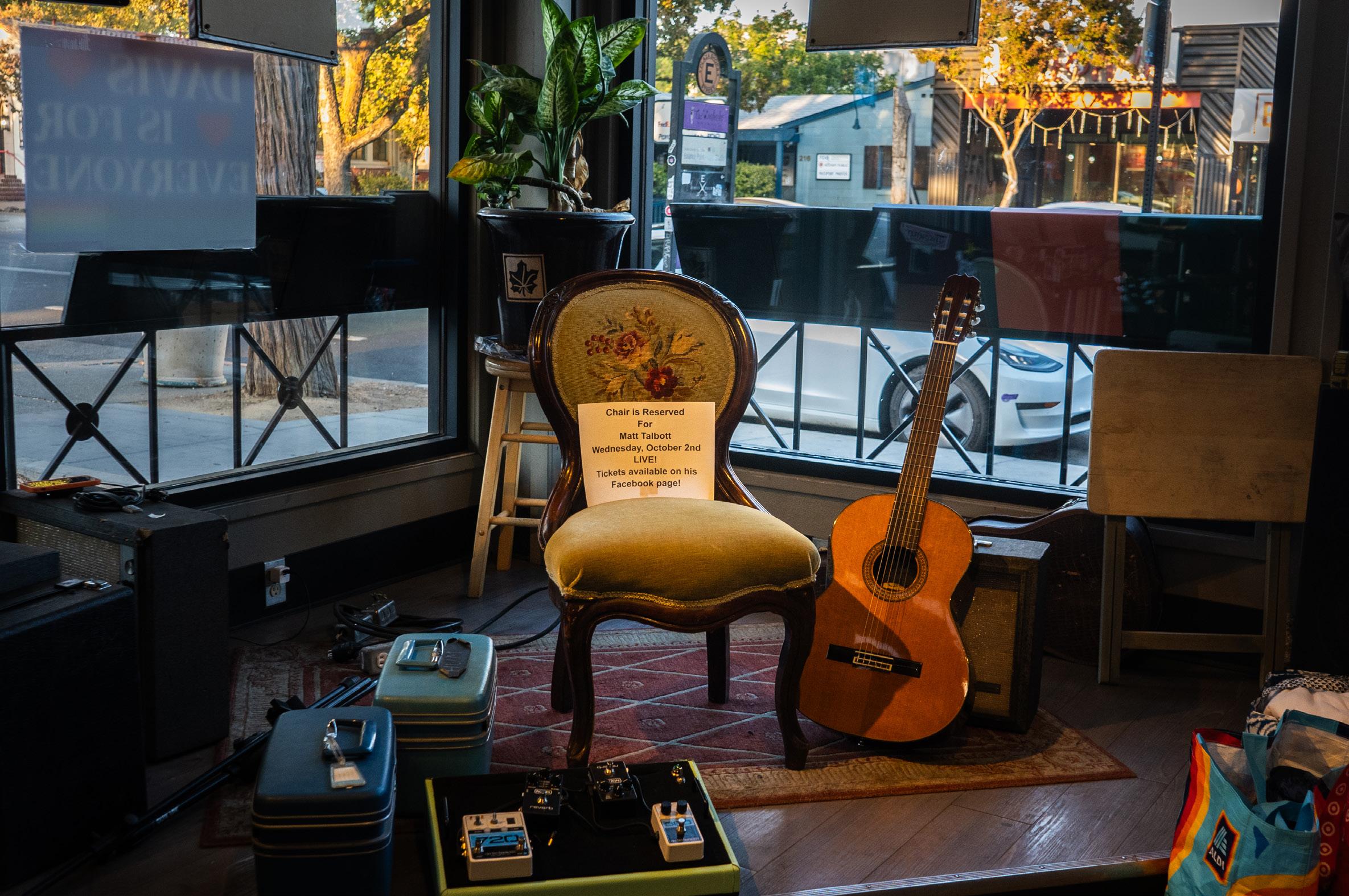
UC Davis’ CALPIRG, Students Demand Action and the Environmental Club advocate for their respective causes, promote student participation in the upcoming election
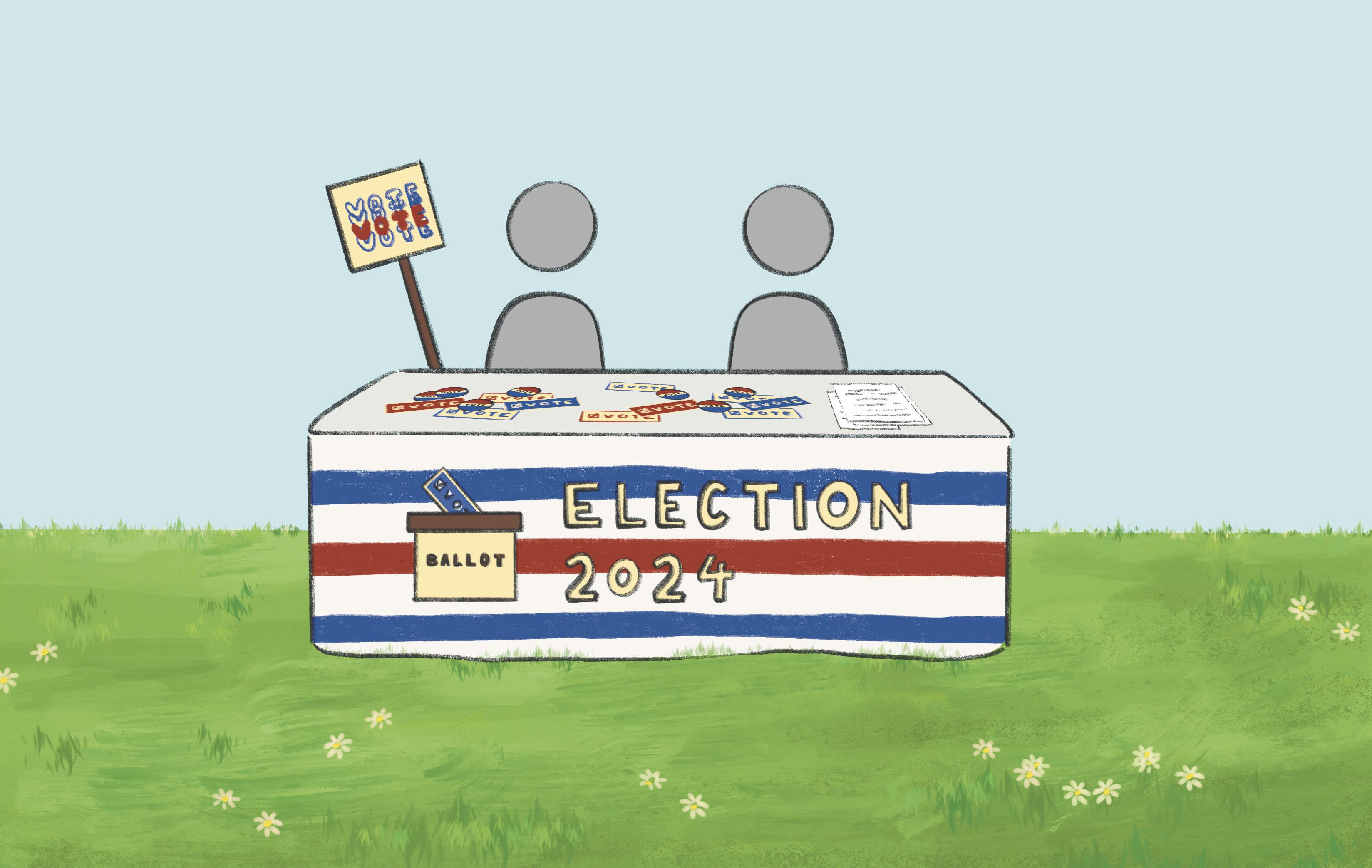
BY GRACIELA TIU features@theaggie.org
With less than a month until the presidential election, UC Davis students have been preparing to vote — some even for the frst time. Various on-campus political and advocacy organizations have been planning diferent ways to help students get ready for November. Among these groups are the UC Davis chapters of California Public Interest Research Group (CALPIRG), Students Demand Action and the Environmental Club, all of whom will continue to host events, activities and projects to further advocate for their respective causes, especially during this election season.
UC Davis’ chapter of CALPIRG prides itself on supporting students in driving social and political change.
“CALPIRG students is a statewide student organization that started here at the UCs in the ’70s to make social change,” Samantha Fabila, a fourthyear political science major and the New Voters Project coordinator, said.
“Our mission is to get students to have the power to shape the future we will inherit. Our chapter provides the training, professional support and resources necessary for students to tackle climate change, protect public health, strengthen our democracy,
feed the hungry and more.”
Trough CALPIRG at UC Davis, students have had the opportunity to participate directly in civic engagement, most recently marked by a win in September with the passing of SB 1053, a statewide ban on plastic grocery bags, after mobilizing support and lobbying in Sacramento.
Teir advocacy has continued into the election season, with them posting on social media for National Voter Registration Day, tabling on campus and working on the statewide campaign the New Voters Project.
“Te CALPIRG New Voters Project has helped register young people to vote since 1984, and it is completely nonpartisan,” Fabila said.
“Since then, we’ve helped register more than two million young people to vote and made more than three million personalized Getting Out to Vote contacts. Te New Voters Project focuses on the magnitude of young people losing their voice by not voting. Tis may be due to students either lacking the knowledge of how to vote or just not fully comprehending the signifcant impact that voting can have.”
With all of their political and civil work in mind, Fabila explained how the students of CALPIRG value public participation.
“When young people don’t vote, it means policies are often ignored on
issues that matter to them the most, like climate change and education,” Fabila said. “Plus, if they don’t engage, they might feel even less connected with politics, creating a cycle of apathy. By aiming for an 86% youth turnout, we’re not only striving for high engagement but also working to create a future where young voices are recognized and valued.”
Another organization on campus, Students Demand Action at UC Davis, has also been actively working to get students involved and further their mission.
“Our main goal is just to work towards gun violence prevention and ending gun violence throughout America,” Samya Rizvi-Syed, a secondyear political science and managerial economics double major and copresident of the organization, said. “In terms of the election, we believe in electing gun-sense candidates, especially up and down the ballot regarding all levels of government.”
With voting being one of the most direct ways to work toward gun violence prevention, the organization has been hosting events and spreading awareness about voting and the upcoming election.
“As a club, we’re hosting electionrelated activities like phone banking, where we usually call registered voters to inform them about the candidate that’s running and encourage them
to show up and vote, canvassing, where we go door to door, talk to people and inform them about the current election, and voter registration workshops,” Rizvi-Syed said. Students Demand Action at UC Davis has particularly noticed the importance of mobilizing the vote for candidates that align with their goals of gun violence prevention.
“Our goal is to not only just bring awareness to the election but also make people aware of who we’re electing and make sure we’re electing gun-sense candidates because guns are the leading cause of death in our generation,” Rizvi-Syed said.
Yet another campus group working in advocacy and election preparation, the Environmental Club at UC Davis has continued to work toward their goals of sustainability and nature appreciation.
Te Environment Club’s mission is to promote and encourage UC Davis students to make cleaner choices, as well as fnd their passions and enjoy nature,” Vanshika Kanodia, a thirdyear neurobiology, physiology and behavior major and president of the club, said. “We do multiple activities such as recycling, upcycling, career panels, helping community gardens, peaceful protests, hikes and beach cleanups.”
Te club also encourages its members and the wider community
to vote in the upcoming election, mentioning plans to incorporate the topic into their general meetings in preparation for November.
Kanodia describes the signifcance of voting and voter engagement, especially regarding the environment.
“Voting is really important because of the impact elections will have on a lot of environmental decisions,” Kanodia said.
“Te U.S. is one of the largest contributors of carbon emissions, so we want to do something about it. UC Davis is doing a lot about it, but we as students also need to do so. Tis ties back to our club, because we want to make sure that not only are we spreading the impact [of preventing climate change] in California and [at] Davis, but if we have proactive behavior in the U.S. for climate change and the environment, that will encourage people to get out in nature more often.”
Because of groups like CALPIRG, Students Demand Action and the Environmental Club, students at UC Davis have countless opportunities to get civically educated and engaged in our country’s democratic process. For more resources regarding voting and the upcoming election, visit Aggies Vote.
Enter digits from 1 to 9 into the blank spaces. Every row, column and 3x3 square must contain each digit. Each Sudoku has a unique solution that can be reached logically without guessing.

In 2023, Texas and Florida challenged, respectively, 1,470 titles and 2,672 titles per the data made available by the American Library Association. Tese were the highest numbers of challenged titles among the 50 states. Meanwhile in California, Governor Gavin Newsom signed the California Freedom to Read Act into law on Sept. 29, 2024. Tis law prohibits public libraries, which includes school libraries, California State Libraries and library districts, from limiting the distribution or sale of books on the basis of the topics and materials within it. It will go into efect on Jan. 1, 2026. The bill would prohibit the governing board or body of a public library, or any body or commission designated to review the procurement, retention, or circulation of, or access to, library materials, from (1) proscribing
the circulation or procurement of, or access to, library materials in a public library because of the topic addressed by the library materials or because of the views, ideas, or opinions contained in materials or (2) creating policies or procedures that limit or restrict access to library materials offered by the public library, except as provided,” the bill reads.
The increasing attempts of censorship on literature within the U.S. is a crucial problem that communities must continue to fght. Book bans can impact education, diminish the diversity of author’s voices, discourage literature engagement and reduce access to incredible stories. Yolo County Library and local Davis businesses are proud to distribute and sell titles that have been challenged and unite against book bans.
“In my 38 plus-year career across four library systems, I have seen many materials challenged by groups or individuals,” Love said. “But not one of those challenges was successful.”

This “one-stop shop for music” keeps its doors open in the face of difficulty
BY LAILA AZHAR arts@theaggie.com
Watermelon Music is described by those who operate it as a “fercely independent” music store. Te shop has been considered a Davis staple since its opening in the 1970s and is proud to be a non-commercialized, family-friendly store that has aspired to be a “go-to” for musicians based out of Northern California.
Following COVID-19, the store was facing serious fnancial struggles; in the face of these hardships, the business decided to make some alterations in order to prevent Watermelon Music as a whole from going under.
On May 3, local Davis music store Watermelon Music announced its closing with the Davis community.
“It is with a complex mix of emotions that I must announce the winding down of Watermelon Music,” Jef Simmons, an owner who has worked at the store for 35 years, said. “I have always tried to operate with integrity and transparency, and it is important to me that I exit on my own terms, with clean hands and obligations met.”
Initially established as Second Street Music, the store has been around for over 50 years, existing as Watermelon Music for 28.
Brian Aguilar, who has worked at the store for 12 years, described it as “a one-stop shop for music,” providing instruments, sheet music, lessons and other equipment.
In recent years, the increase of online sales has put Watermelon Music in a difcult spot. COVID-19 in particular sent the store into debt, as equipment was purchased in anticipation of a school year that never came.
During the summer of 2023, a GoFundMe aimed to help the store fnancially and keep its doors open raised over $100,000. However, unsure of how stable the future would be, Simmons made the difcult decision to begin closing operations.
“I can’t see a clear path toward becoming proftable again, without a complete rethinking of the model that has worked for so many years,” Simmons said.
Despite this, members of the store and members of the community came together, refusing to see a beloved
pillar of the Davis music community close its doors.
Aguilar, along with another employee, Eric Wellington, stepped in to become the managing partners of Watermelon Music. Tis transition involved downsizing — the store will no longer carry orchestra or band instruments or provide instrument rentals. Additionally, the amount of sheet music the store carries will be signifcantly reduced, going from 30,000 titles to 300, specifcally keeping the sheet music needed by local teachers.
Te instructors who taught music lessons at the store have now formed the Watermelon Music Academy, which will be continuing as an ofshoot of Watermelon Music.
Additionally, a non-proft organization called the Friends of Watermelon Music rallied to support the store, taking over part of the building with the goal of providing instrument rentals. Aguilar said that during this
transition, Simmons was encouraging and supportive.
“He has facilitated this transfer of leadership here to Eric and myself in a way that would not have been possible with almost any other business owner,” Aguilar said. “He wants to see what he built live on, and he wants to see the community be served.”
It is precisely this loyalty to the community that has saved Watermelon Music. Te store hosts a variety of open events and communicates with local schools to ensure that students and teachers have the equipment they need.
Customers often express how long the store has been a part of their life when they come in, according to Aguilar.
Tere are so many people who are like, ‘Oh I’ve shopped here for this many years, and I’ve known Jef since he was in college,”’ Aguilar said.
Tis close relationship among local people and businesses is something that an online retailer or a large
corporation could never replicate. Even as the store faces difculty, the community’s connection to Watermelon Music motivates them to ensure it remains an available resource.
Aguilar said he hopes to host one community-oriented event each month. At the end of October, Watermelon Music will host a familyfriendly haunted house. In November, the store plans to partake in its annual “Strings for Food” initiative, in which they restring guitars in exchange for two cans of food, which will be donated to a local food bank.
Friends of Watermelon Music has plans to ofer classes in nonwestern music, as well as to become a consignment store where people can sell their old music equipment.
Jenny Le, a second-year managerial economics major, said she was excited for the future of the newly modifed store.
“Online shopping and big retailers have made life difcult for small businesses and locally owned
businesses,” Le said. “It’s cool to see a store like Watermelon Music manage to stay open despite that.”
Rania Asad, a second-year neurobiology, physiology and behavior major, said she appreciated the community aspect of local businesses like Watermelon Music.
“People learn music alone or with a very small group a lot of the time,” Asad said. “But it can really connect a lot of people, and a store like this is a space for that to happen.”
Currently, as the store is clearing out items they will no longer continue to stock, many items are on sale at 50% of. In partnership with the local art studio, a kiosk at Secret Spot ofers Watermelon Music items. As changes take place, Aguilar encourages folks to take advantage of these resources ofered by Watermelon Music, as well as to support the business so that it can remain a part of the Davis community for years to come.

Students moving in and out creates an
How excess furniture during student housing transfers has impacted Davis
BY NOAH HARRIS features@theaggie.org
Many students at UC Davis choose to live of campus after a year in the dorms, dealing with the oftendaunting task of fnding and living in an apartment or house. For many students, their new residences are not furnished before they move in.
During the fast-paced graduation season and the new school year, it is likely that Davis residents will see furniture on the street, discarded while students hurry to move out and make way for the next batch of students who need their apartments to be furnished. One business trying to combat this problem is Community Mercantile, a non-proft organization that takes in secondhand items such as furniture, tools and books.
Lois Erhartic, a board member of Community Mercantile, described their company-wide mission.
“[We want to] keep things out of the landfll, to fnd ways to repurpose,
reuse,” Erhartic said. “Anything but the landfll, because to reduce the waste and the toxins that come from that, [we need] to reduce the need to manufacture because of the waste that comes from manufacturing.”
Erhartic further described what their aim has been for the shop.
“Our point is not to have a thrift shop, our point is not to accumulate funds from a thrift shop,” Erhartic said. “Our point is to keep things out of the landfll.”
In late August and September of this year, Stephanie Koop, one of Community Mercantile’s founding members, held a garage sale outside. Erhartic was shocked at the garage sale and how quickly its contents were acquired.
“[Tere is] a video that I took probably around the last week of August, and it was things that Stephanie collected of the streets of Davis in one week, and I took a video of it,” Erhartic said. “It flled her garage, her driveway and [...] her whole courtyard.”
While it might create a business opportunity for some, it is a violation of the city code to leave furniture and other items, such as mattresses, out on the street or sidewalk, according to the city of Davis. Tis can create hazards for bikers and pedestrians, and it can be visually appealing for the community.
However, there are options to move items that do not require selling or giving them away. At the end of May, the city of Davis sends out mail to every resident, giving them a onetime voucher to bring a car’s worth of discarded items to the county landfll to be recycled. However, while the Yolo County Landfll does have a thrift store, they do not take items such as upholstered furniture, mattresses and large appliances.
Last year in the U.S., about 900,000 fewer homes changed ownership than they do in a typical year, according to Te New York Times, and the average American relocates 11.7 times in their lifetime, according to Nasdaq. However, Davis
is diferent from most places, as frst-year students tend to live in the dorms, while returning students are not guaranteed a spot in the residence halls. Many returning students live in of-campus apartments.
In one article from 2022, UC Davis asserts that 38% of students live on campus, including Te Green at West Village, where frst-year students do not typically live. Regardless, this means that a signifcant portion of UC Davis students will have moved at least twice — once into the dorms and again into a residence outside the dorms.
Kelli Ann O’Day, the assessment program manager with UC Davis Sustainability, explained what this means for the city.
Te turnover rate of people moving in and moving out with Davis is especially high because of the student population,” O’Day said.
“When you’re [frst] going to school, you think about [going] and then leaving. You don’t really think about the fact that there’s thousands of

students every year kind of doing the same thing.”
Koop had an idea that the university could implement to save large items from going to the landfll.
“What I would like them to do is to provide a space for the students between graduation and when the new students move in in August, September and October, for the students moving out to place [...] their used stuf there so that the new students can come in and either purchase them for a low price or just have them free,” Koop said.
When asked about implementing a space for secondhand items, O’Day had a positive reaction but was unsure about how that could become a reality.
“It feels like we have a really big campus,” O’Day said. “But as far as places where you could safely leave furniture and maybe protect it from the elements, could it be an outdoor place, or would it need to go inside?
Tat would be a larger conversation.”
On Community Mercantile’s website, they state that they are not accepting donations until mid-November.
Tere’s a simple explanation for their inability to do so, according to Erhartic.
“It’s space. It’s simply space, and we would like to fnd some bigger space that works within our budget when our lease is up, but nothing is a given,” Erhartic said. Davis is certainly not the only place where this problem can be found. At UC Los Angeles, there are over 1,500 bulk pickup requests in late August during move-out time. Tis has created piles of large items laying outside, even blocking sidewalks with the sheer amount of furniture.
Tere are several options for giving away secondhand items in Davis, including Goodwill, the Yolo County SPCA and Facebook Marketplace. Tere is also an on-campus thrift store called the Aggie Reuse Store which is an option for secondhand clothes, school supplies and small appliances. However, they are a very small store and do not accept large appliances such as electronics or furniture.
Right now, there seems to be a slight disconnect in efectively reusing and giving away secondhand items in Davis. In the future, many residents such as O’Day, Erhartic and Koop hope that positive change will occur with collaboration between local businesses and local government. Hopefully soon, there will be a more productive solution to furniture-based waste in our community.
While it’s not uncommon to need additional screening, this can evoke significant fear in patients
BY KATIE HELLMAN science@theaggie.com
Mammograms are used for the early detection of breast cancer, and they are a life-saving tool. Te test utilizes X-rays to create images of breast tissue that can be examined for masses or anything else of concern.
A fallback of mammograms is that they have the potential to give false-positive results. If women are called back for additional screening, it can lead to signifcant amounts of emotional distress even when the process does not result in a cancer diagnosis. Te UC Davis Comprehensive Cancer Center conducted a study and found that when women received a false-positive result, they were less likely to return
for breast cancer prevention exams in the future.
Te study collected data from over 1 million patients between the ages of 40 and 73, using over 3.5 million mammograms from 2005 to 2017. Te results, which were published in the Annals of Internal Medicine, implied that this can lead to undiagnosed breast cancer occurrences for the women who choose not to return for more screenings.
“Women were less likely to return to screening after false-positive mammography results, especially with recommendations for short-interval follow-up or biopsy, raising concerns about continued participation in routine screening among these women at increased breast cancer risk,” the study reads. Diana Miglioretti, chief of the
Division of Biostatistics at UC Davis and researcher in the cancer center, discussed the implications of these results in an interview with UC Davis Health.
“It is important for women with false-positive results to continue screening every one to two years,” Miglioretti said. “Having a falsepositive result, especially if it results in a diagnosis of benign breast disease, is associated with an increased risk of being diagnosed with breast cancer in the future.”
77% of patients who had a mammogram with a normal result came back for future tests, compared to only 61% of those who had a falsepositive result and were supposed to come back for follow-ups. If a biopsy was suggested, 67% of patients returned. If a false-positive result were
to occur on more than one occasion, only 56% of women returned. Tese results are important, because false positives are not an uncommon occurrence. In patients between the ages of 40 and 49, there is a 10-12% chance of receiving a falsepositive result after a mammogram. If someone were to have yearly mammograms for a decade, there is a 50-60% chance they would receive a false-positive result at some point, and there is a 7-12% chance their result would be accompanied by a recommendation for a biopsy.
An article by Susan G. Komen, an organization that aims to make an impact against breast cancer, explains why mammograms should not be avoided for this reason.
“If you’re called back to check an abnormal fnding on your
mammogram, it’s normal to be worried or concerned,” the website reads. “However, false positive results are common. Most women who are called back don’t have breast cancer.” False-positive results occur for a wide variety of reasons, including having dense breast tissue, overlapping tissue or calcifcations. Even if additional screening is suggested following a mammogram, that does not mean there is reason to panic — around 10% of the time, extra imaging is recommended, but that doesn’t necessarily indicate a cancer diagnosis. Getting these scans should not be avoided due to the potential for false positives, as they are a crucial component of preventative healthcare.

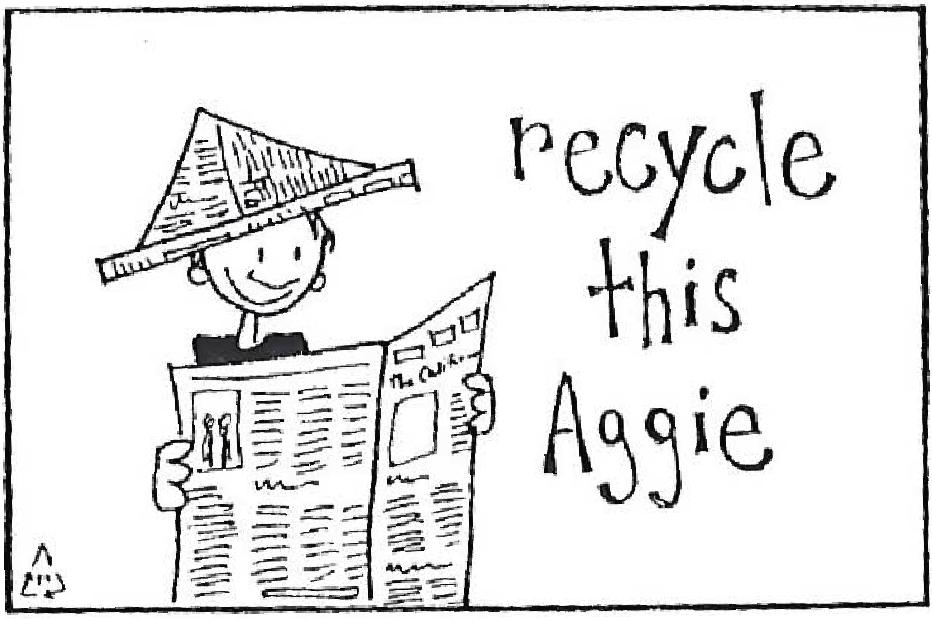

Despite the loss, UC Davis looks forward to the rest of their season
BY KRISTA HAJJAR sports@theaggie.org
Te UC Davis Aggies played another home game against the California State University, Long Beach (CSULB) Elbees on Sept. 26. UC Davis fought hard and won the frst set, but Long Beach State fought back and ultimately won the game.
Te Aggies were hoping to start strong with a lead in the game as they scored the frst point of the set. However, the strong start was shortlived as the Elbees stole the lead. CSULB kept a distance of three to four points throughout the set, making it difcult for UC Davis to catch up to them — but that didn’t stop them. Te Aggies put an end to the Elbees’ scoring at the 17th point when Jade Light, a third-year aeronautical engineering major, scored a service ace, placing the Aggies only a point behind with a score of 17-16.
UC Davis’ streak continued as Long Beach State missed a point, tying the match at 17-17. Te rest of the frst set was neck and neck with both teams ultimately remaining tied, at 21-21. Te Aggies didn’t hesitate and continued to fght in the frst set and ultimately fnished with a victory block by Allie Caldwell, a secondyear undeclared major, and Olivia Utterback, a fourth-year human development major.
Te second set wasn’t as favorable to the Aggies as the frst set. Within the frst 15 points of the second set, the Elbees gained a six-point lead over the Aggies, making the score 104. UC Davis did their best to close the gap by scoring three points back to back, however, CSULB didn’t let them get too far ahead. Head Coach Dan Conners called multiple timeouts during the set, but even with the constant communication between coach and players, UC Davis took a loss during the second set with a fnal score of 25-15.
With set wins being tied 1-1, the Aggies stepped into the third set gaining a two-point lead from the Elbees. Te lead was once again shortlived as Long Beach State managed to score four back-to-back points. Utterback then cut of their winning streak by scoring a point and keeping the gap down to a one-point lead in favor of the Elbees. Both teams were back to being neck and neck, until CSULB scored seven consecutive points, turning the score into a seven-
point lead. While the Aggies tried their best to close the gap, the Elbees didn’t let up and swept the third set with a fnal score of 25-17. Te fourth set started of strong for the Aggies as they took the lead by scoring the frst fve points with two service aces from Light and two kills from Utterback. Te Elbees quickly worked hard to close the gap and narrowed it down to another onepoint diference. Both teams fought hard, and the game remained within a one-point diference until Long Beach
State stole the lead within a few plays, creating another seven-point gap. Tough UC Davis tried to come back, they eventually lost the fourth set 2516, and the match went to CSULB. Although UC Davis lost the match against Long Beach State, that doesn’t mean there weren’t any highlights from the players. Light achieved an UC Davis-high with a total of 12 kills, three service aces and 10 digs. Utterback was just behind Light in number of kills with 11 but also had two blocks and eight digs. Mia Starr,
a second-year undeclared major, maintained the UC Davis ofense with 33 assists, 11 digs and two kills. Lastly, Julie Ng, a fourth-year managerial economics major, ended the game with a match-high of 16 digs. Head Coach Dan Conners shared his insight with UC Davis Athletics following the match.
“We didn’t have the best plan for their service, and I take responsibility for that,” Conners said. “We lost the serve and pass battle tonight, so it will be key to game plan for that better
before we face them again. Wins and losses are all part of the journey, and you have to move on quickly and get ready for the next. So we will be ready for UC San Diego on Saturday.” UC Davis went on to win against UC San Diego with a fnal set score of 3-0 and aim to turn this into a winning streak as the season progresses. Te Aggies have had a dynamic start to their season and, despite the loss against Long Beach State, look forward to a season of strong competition and intense matches.

LANHUI ZHEN / AGGIE
The Aggies achieve victory over San José State and Santa Clara University
BY DIEGO CERNA sports@theaggie.org
On Oct. 5, the No. 17-ranked UC Davis men’s water polo team faced of against No. 14-ranked Santa Clara University Broncos and No. 11-ranked San José State Spartans in the Big West-West Coast Conference (WCC) Challenge in San Jose, California. Prior to the one-week tournament, the UC Davis Aggies lost to the Broncos for the frst time in 13 years, with a score of 12-14 at their home pool — Schaal Aquatics Center —
for a non-conference showdown on Sept. 27. In that showcase, Anzar Beltran, a graduate student utility and managerial economics major, scored fve goals and two assists to keep the Aggies in the game, but it was ultimately not enough. However, things played out diferently in this highly anticipated rematch. Beltran started of strong by scoring two goals in the opening quarter. UC Davis then scored three consecutive goals in the second quarter by Adam Ting, a thirdyear attacker and economics major, Timothy Kerr, a second-year attacker
and undeclared major, and Holden Neach, a graduate student utility and managerial economics major. Tis scoring run gave the Aggies a 7-5 lead at the halfway mark.
Beltran and Kerr followed up their performance in the second half, scoring two goals each to gain a hat trick for the game. Kerr also recorded a game-high of three steals. Frank Laptin, a third-year goalie and undeclared major, came up huge for UC Davis on the defensive end, as he snagged up 11 saves and rejected over half of the Broncos’ scoring attempts.
Te Aggies then faced of against
the tournament host, the Spartans, after their victory against Santa Clara University. Te second game displayed more scoring contribution from the team, as seven diferent Aggie players ended up scoring in the frst half, which gave UC Davis an 8-4 lead at halftime. Will Nomura, a utility and fourthyear environmental science and management major, gained a hat trick and sealed the game with a goal in the last two minutes, widening the fnal score to a two-point victory. Tis left the Aggies victorious as the fnal score was 11-9. Laptin came up huge again,
rejecting 13 shots on goal along with two steals. Neach and Beltran each scored twice, rounding out a great overall team win.
Tis tournament proved to be a very good weekend for the Aggies as they came back strong against Santa Clara University and San José State following their recent loss. Although they sufered a series of back-toback losses earlier in the season, they have regained their momentum and seemed to have found rhythm. Te Aggies look to extend their two-game winning streak on Oct. 11 against the No. 10-ranked Long Beach State at Schaal Aquatics Center.
